I’m always adding more, so be sure to follow my shop to get notifications!
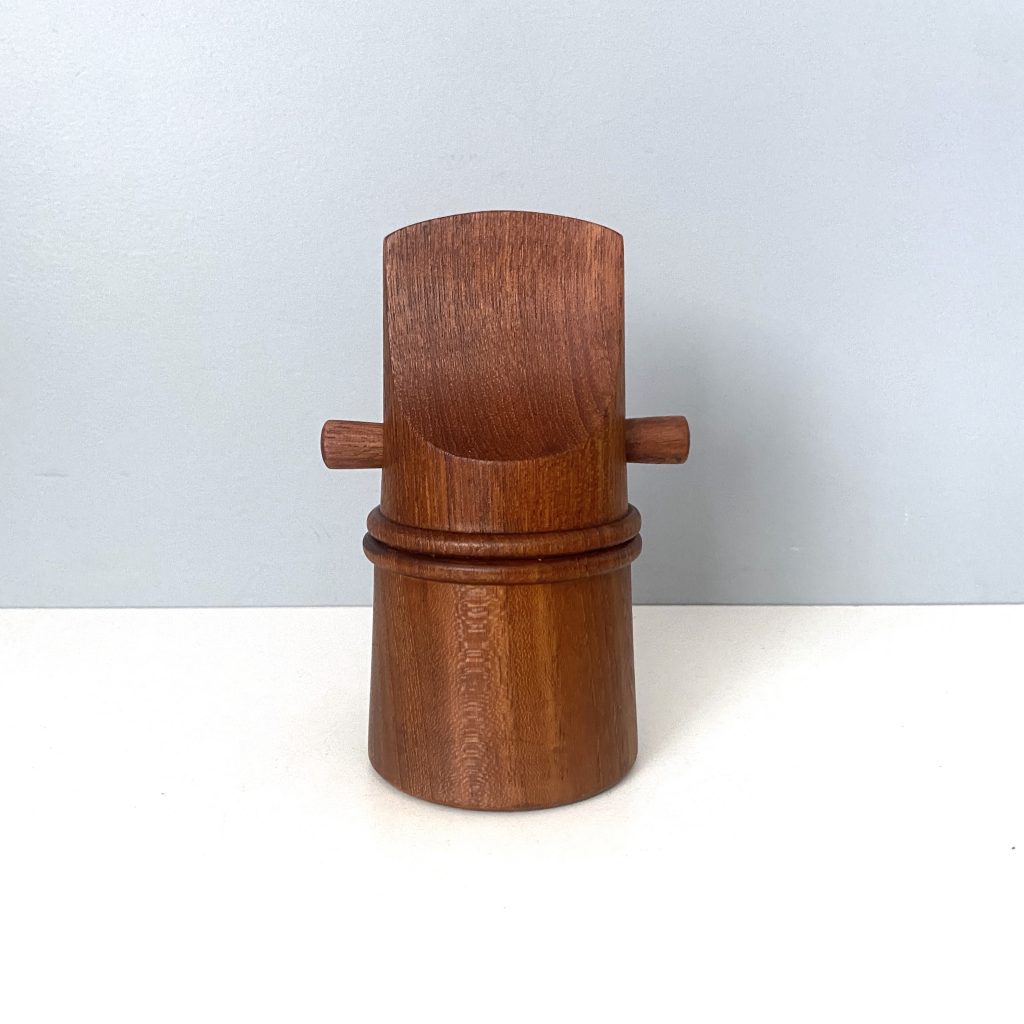
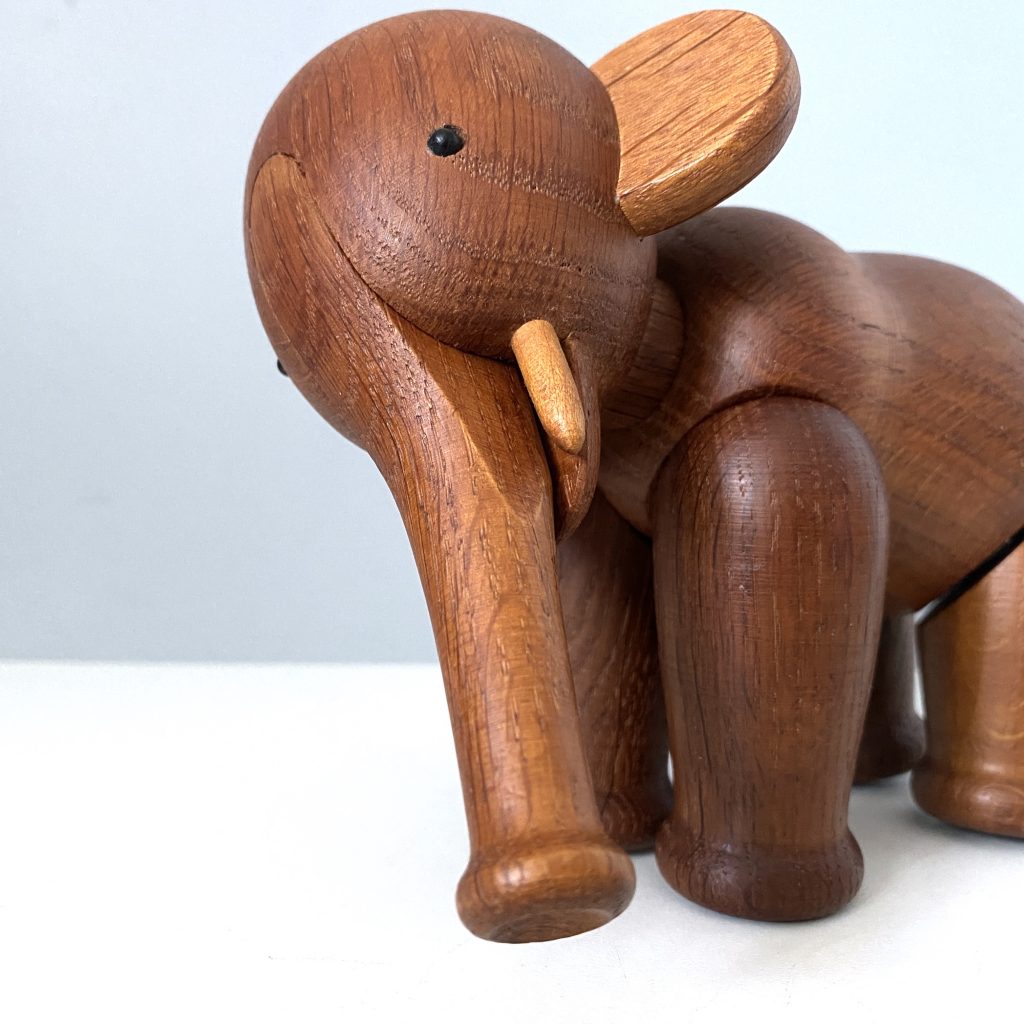
Vintage Kay Bojesen elephant, made in Denmark
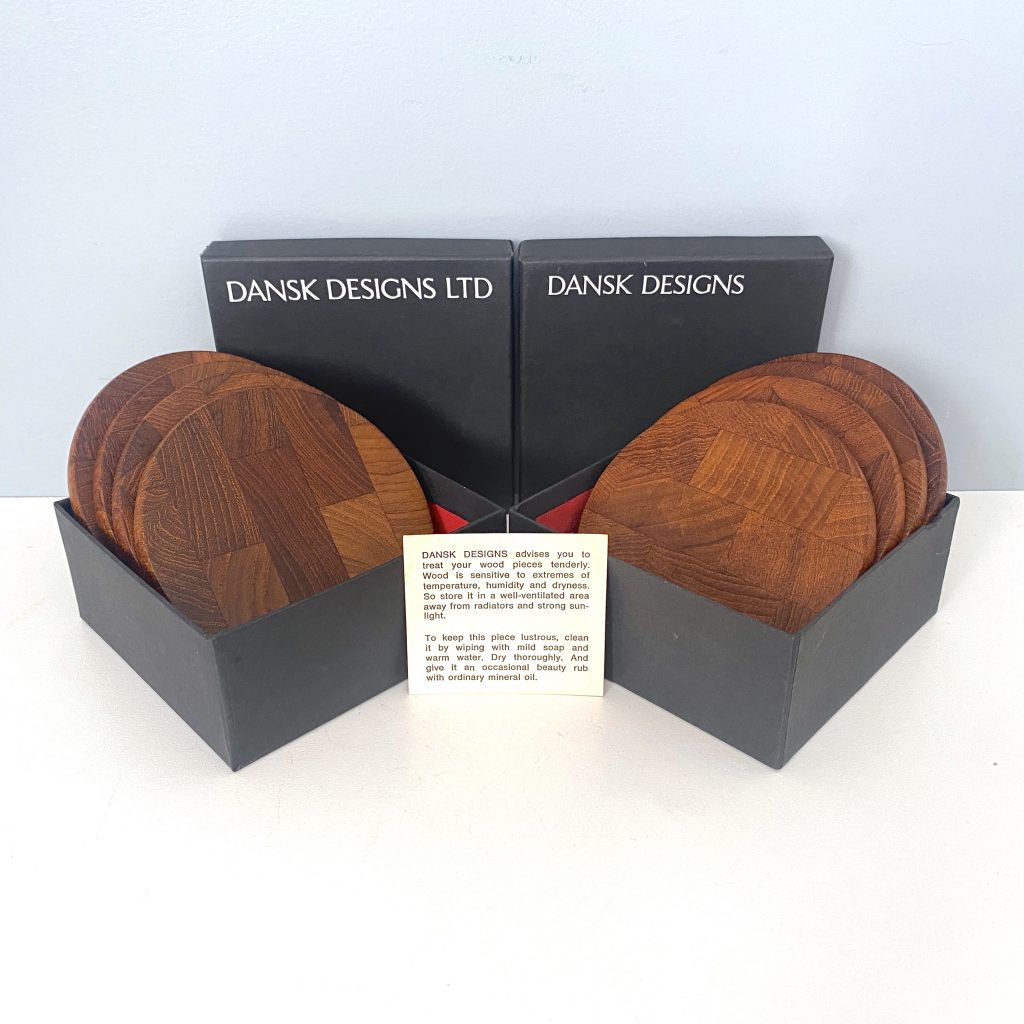
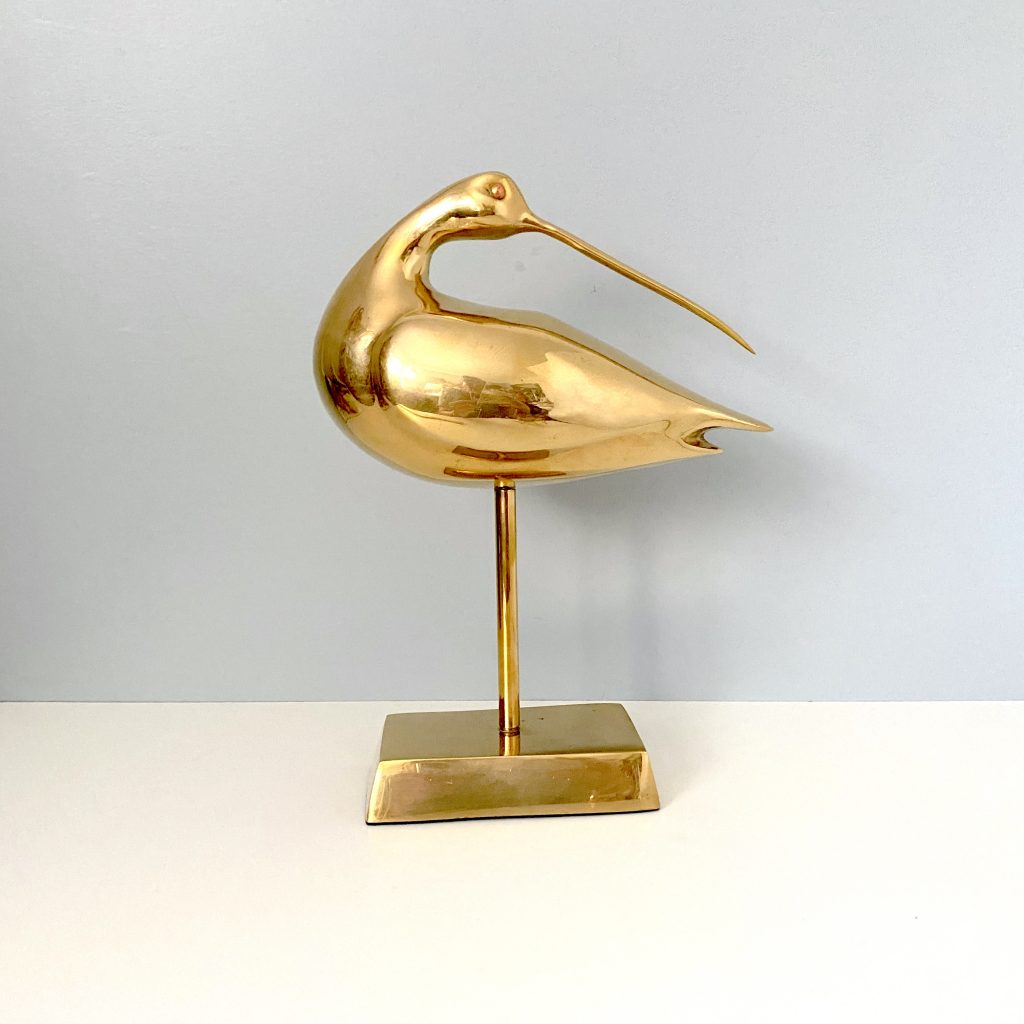
Brass curlew in mid-century style, 10″ tall
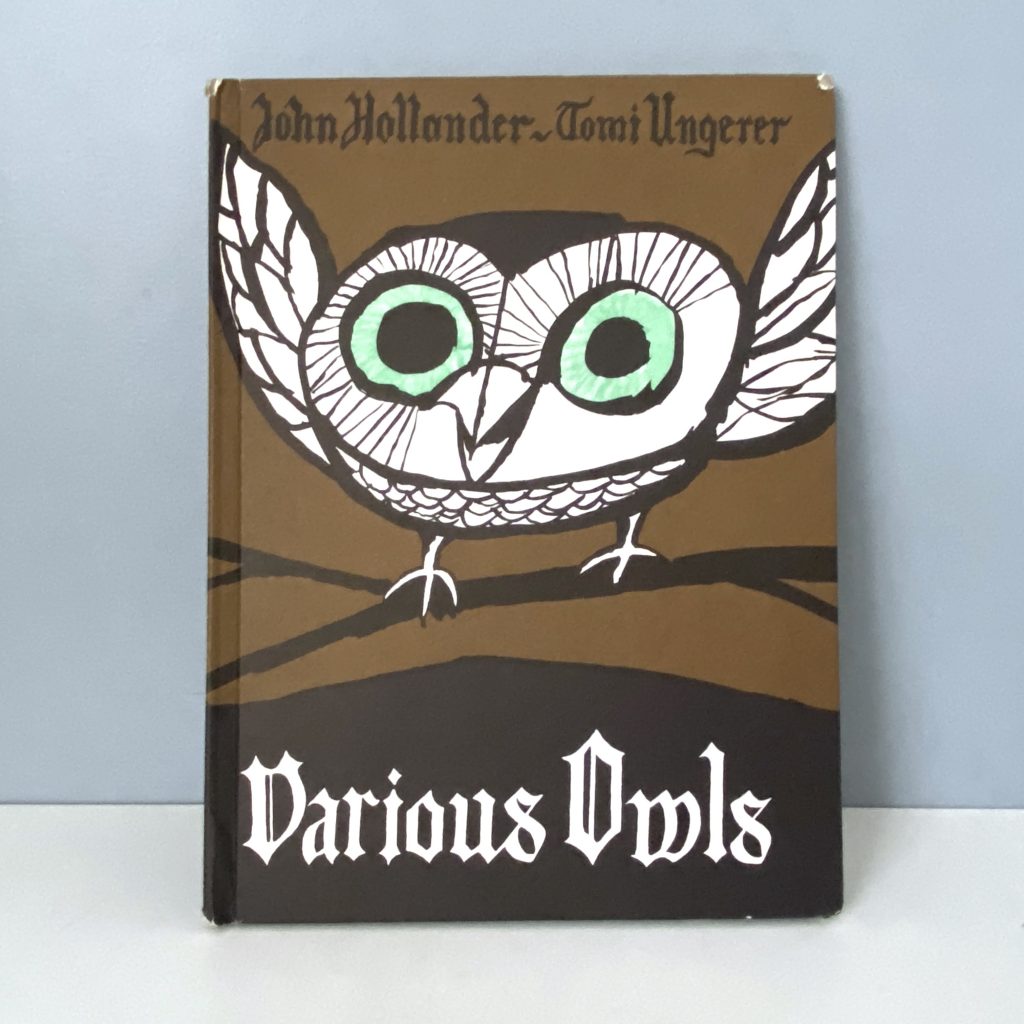
Go to modhuset on Etsy for lots more!
I’m always adding more, so be sure to follow my shop to get notifications!


Vintage Kay Bojesen elephant, made in Denmark



Go to modhuset on Etsy for lots more!
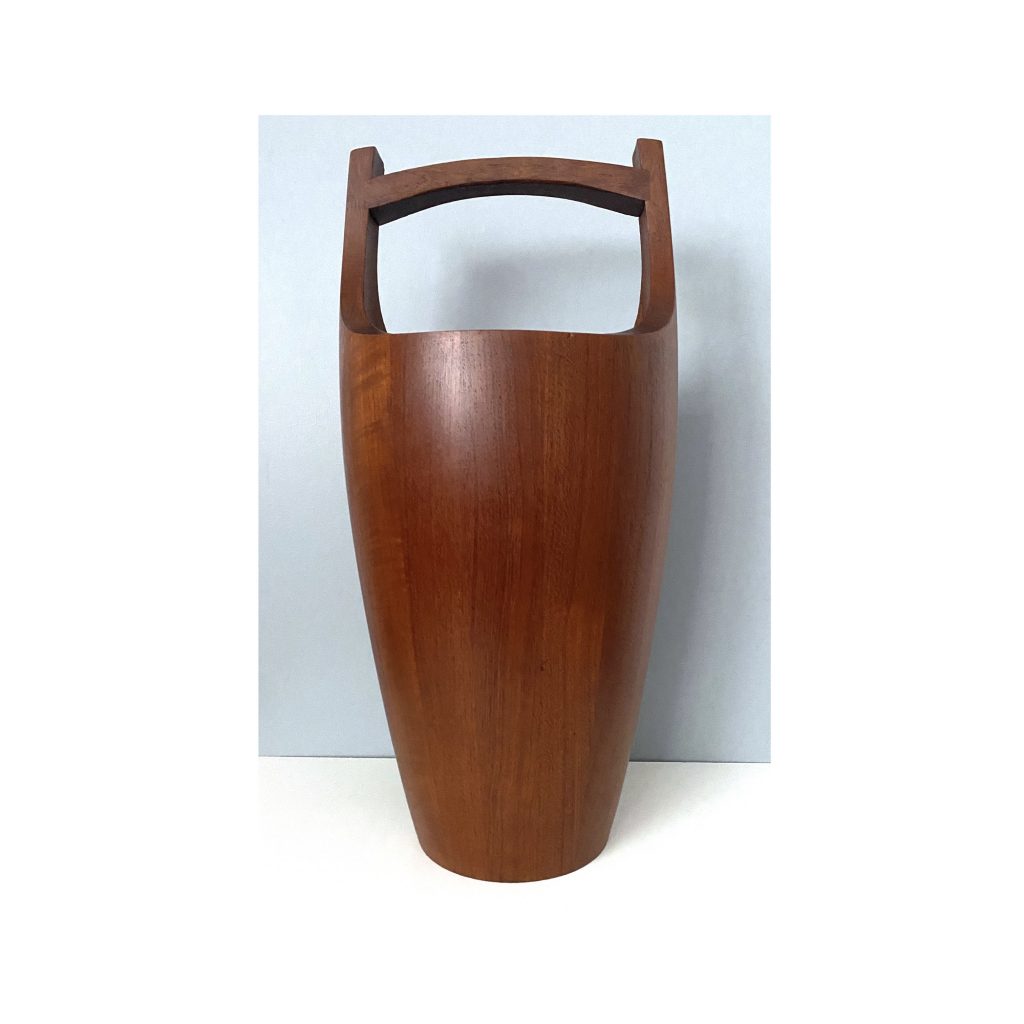
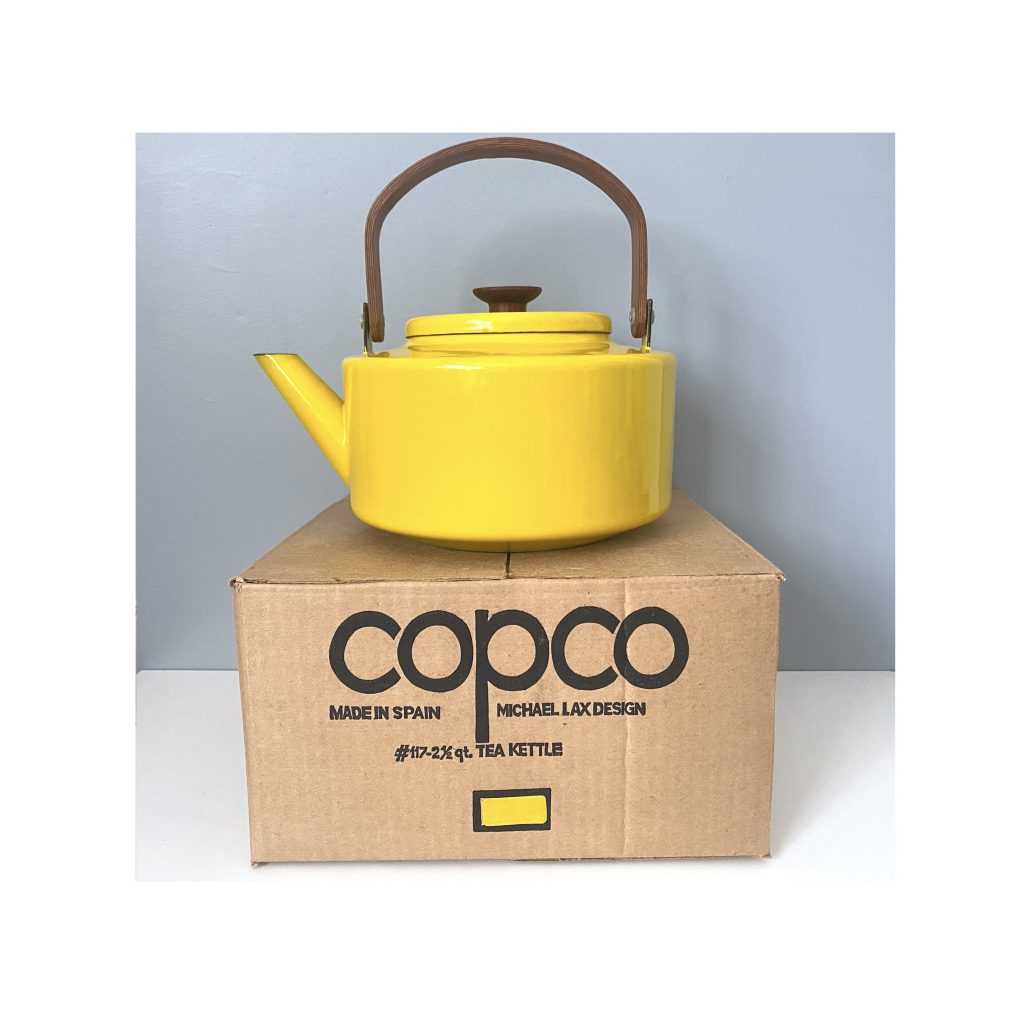
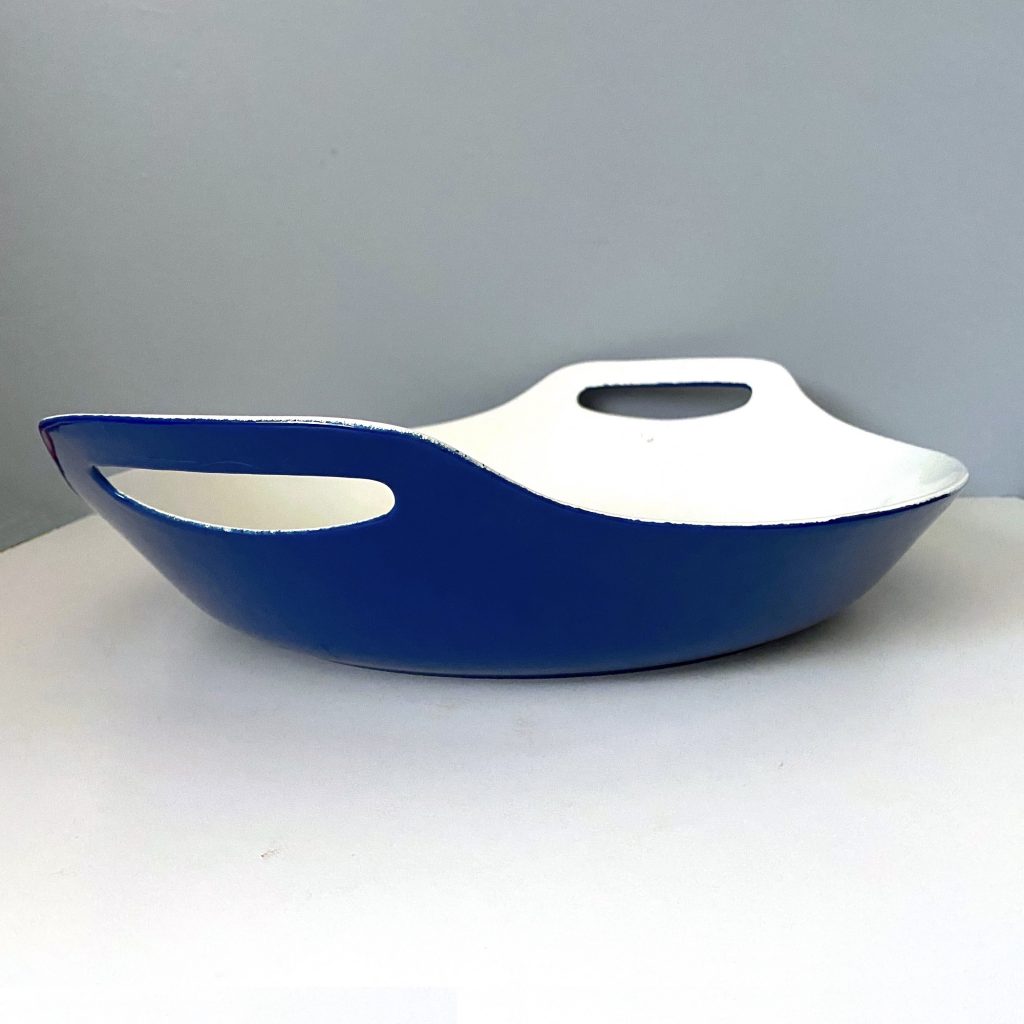
Large 14″ round paella pan designed by Michael Lax for Copco, enameled cast iron
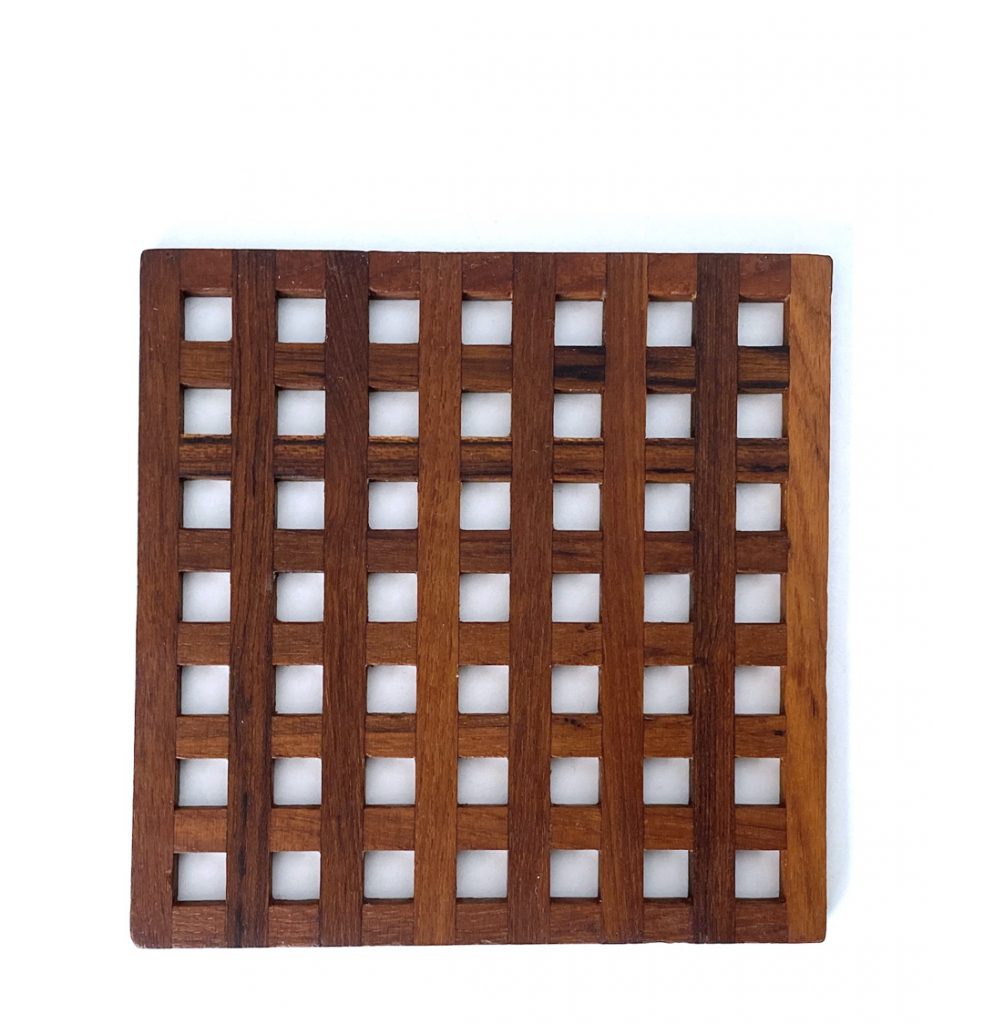
I’m now only operating my Etsy shop, modhuset.
I’m no longer doing any furniture restoration but I’ll be leaving the site up for the time being, just as a resource for people seeking information.
I’ve been hunting and gathering all my life and my collections have finally reached critical mass! I have run out of storage room and am doing that thing where you have to start voting stuff off the island. It’s all on Etsy with more to come–be sure to follow my shop to get updates when new things are added.
July 2020 update of just a few of the current items:
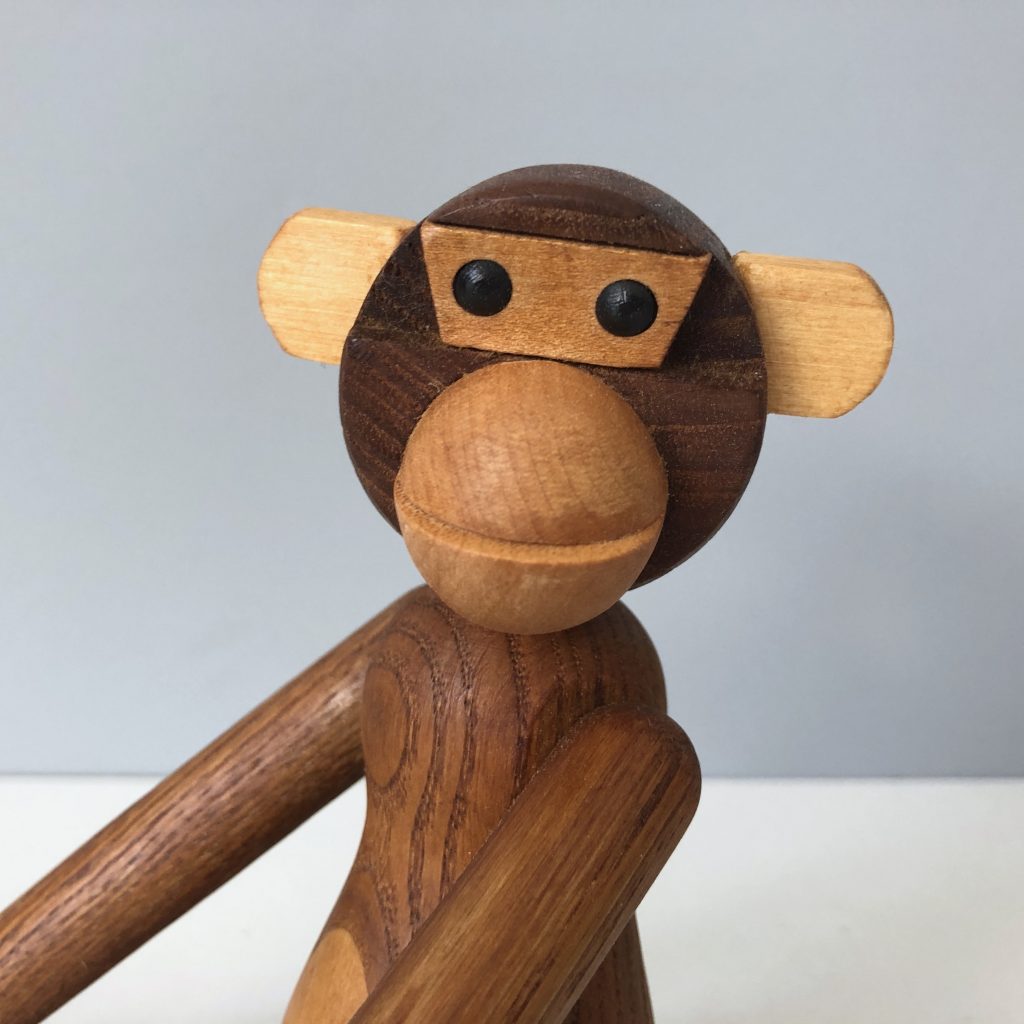 Bojesen-style vintage monkey
Bojesen-style vintage monkey
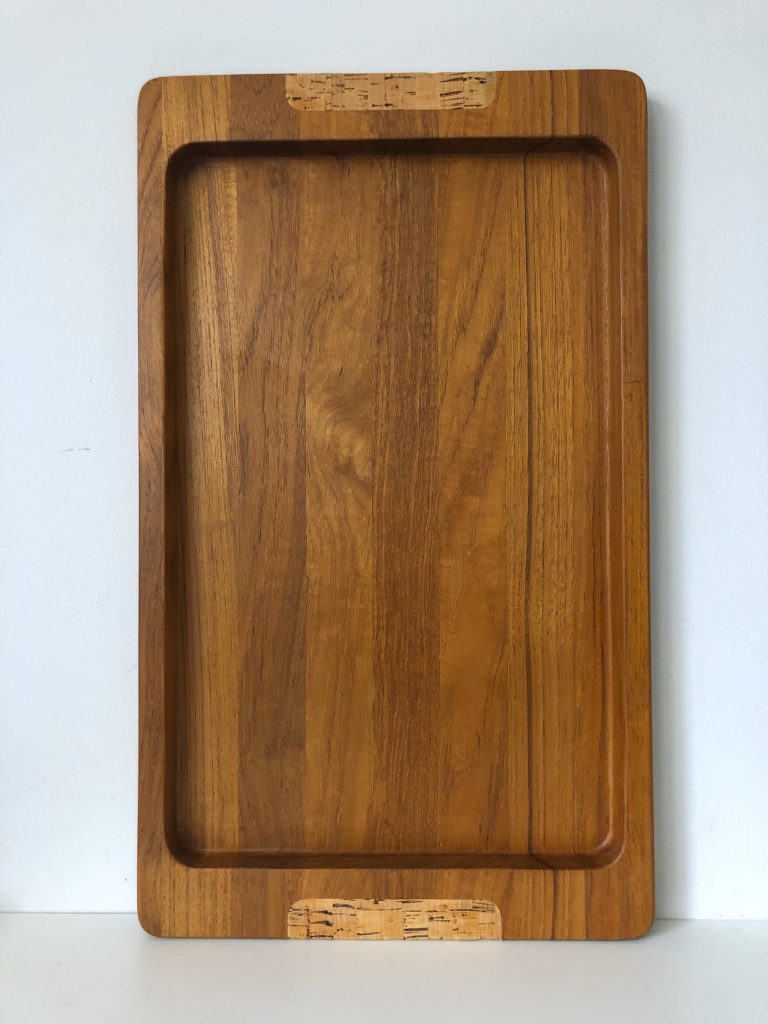 Huge teak tray with inlaid cork handles by Nissen of Denmark
Huge teak tray with inlaid cork handles by Nissen of Denmark
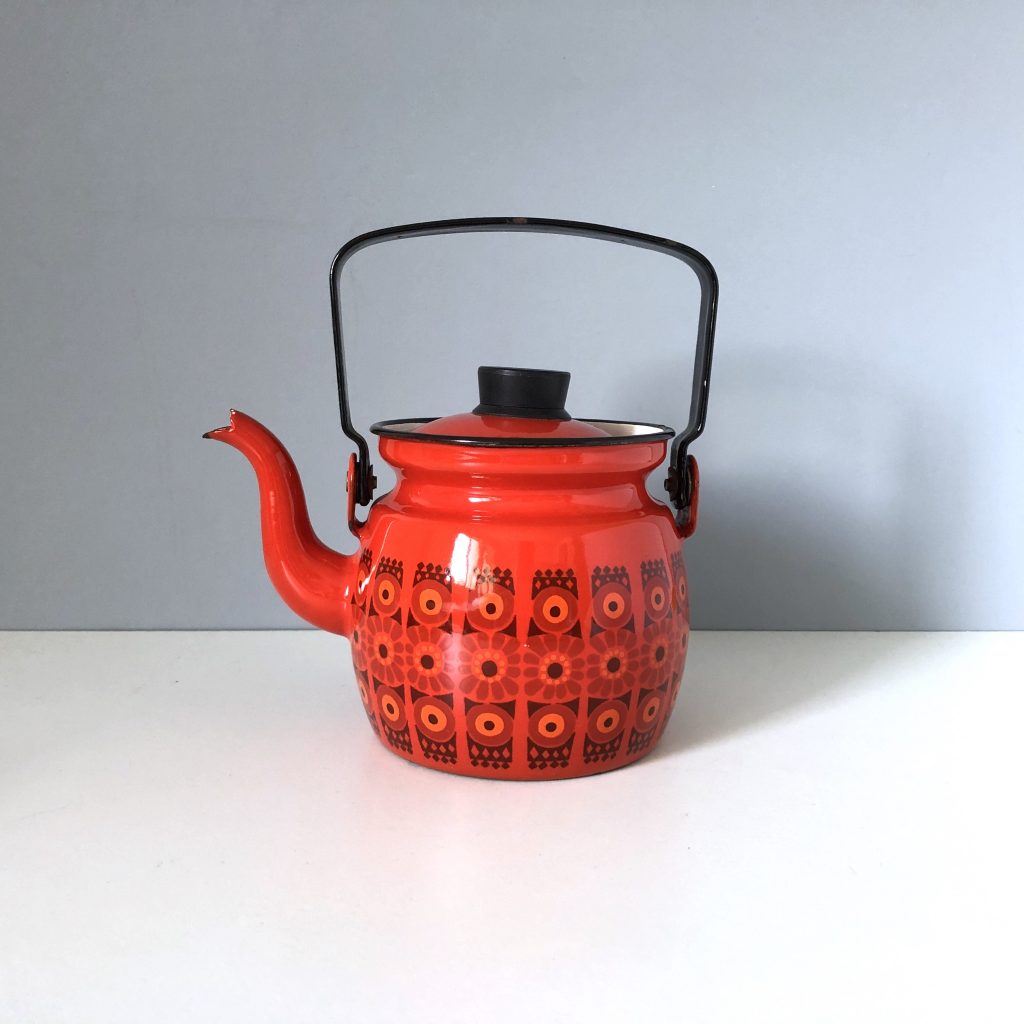 Finel tea kettle, Finland – designed by Kay Franck
Finel tea kettle, Finland – designed by Kay Franck
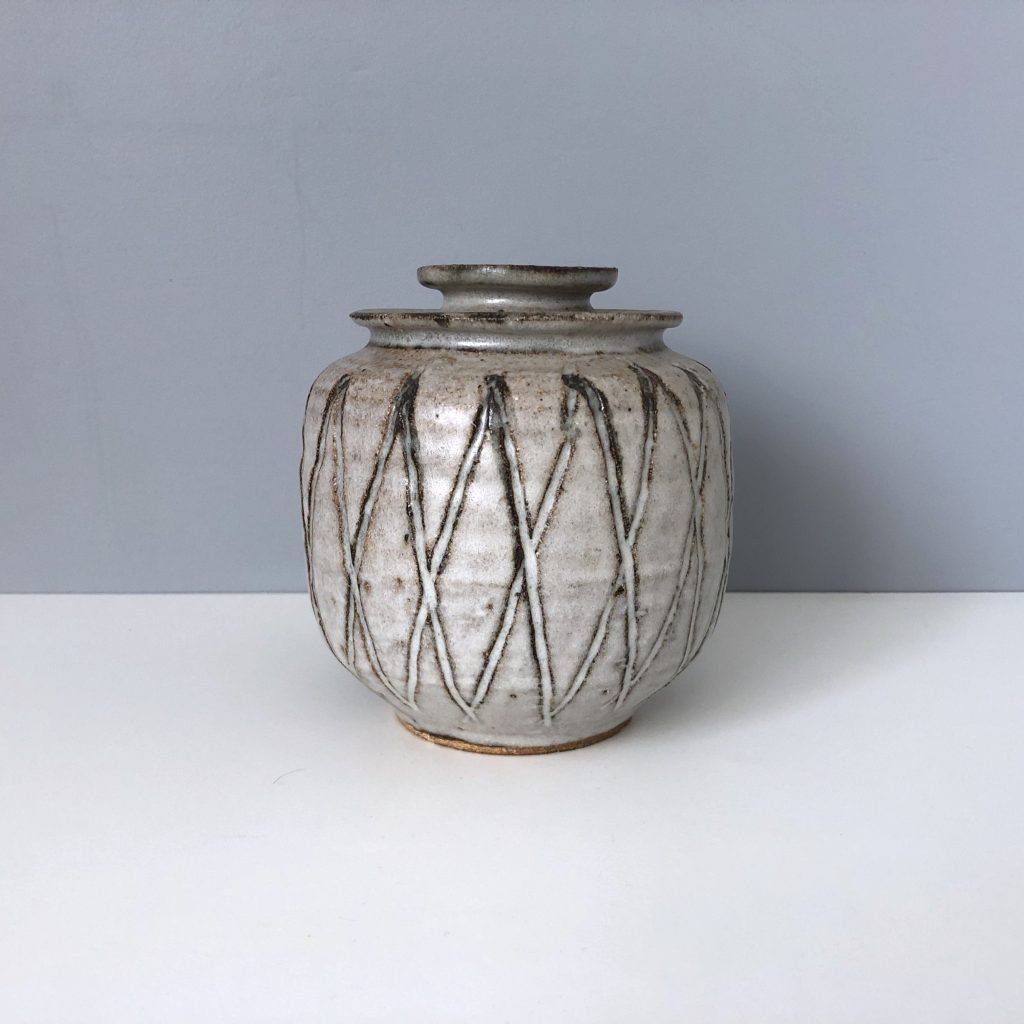
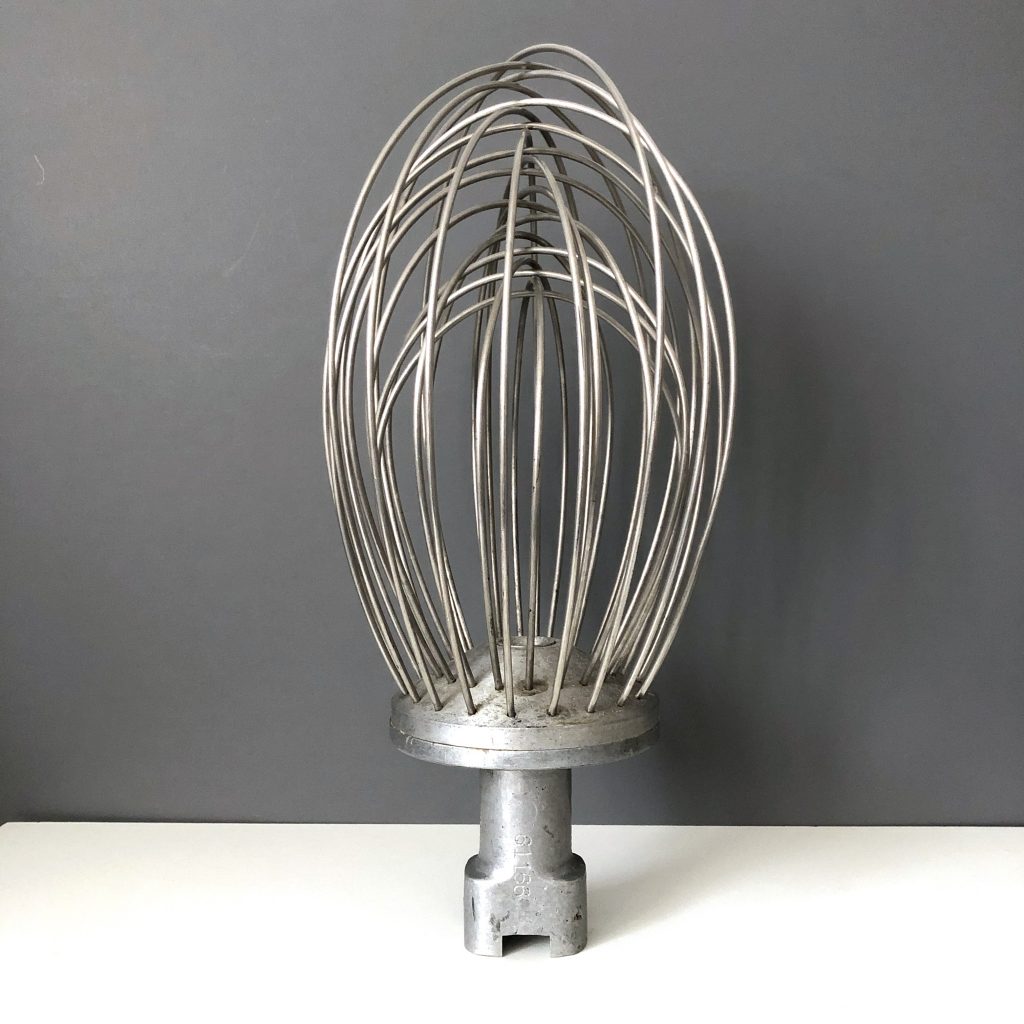
large industrial mixer whip
I’ve been asked many times how to clean and oil teak furniture. Time for a post dedicated to just that!

Maybe you own a teak chair that needs work or maybe you saw one on Craigslist or in a thrift store that looked too far gone to bother with. The good news is that a lot of teak is finished with just oil and oil is one of the easiest finishes to restore and maintain.
The photos above are of the of the same Wegner CH23 chair. All I did was to go over the chair with #0000 steel wool and a generous amount of teak oil. The steel wool cuts through the grime and the oil helps loosen dirt and also lubricates the steel wool so that it doesn’t leave any scratches on the wood. Usually a few passes with the steel wool are all you need, then let the oil soak in for 5-10 minutes. Then simply wipe it off with clean rags or paper towels.
(NOTE: if you use rags, you should not throw them in your washer and dryer afterward. The oil doesn’t wash out very well and can end up coating the inside of your units and kind of making a mess of things.)
Let the remaining film of oil dry for 1-2 hours, then buff vigorously with a clean rag to give it a nice glow. (If you forget to do this step and you end up with gummy-feeling wood the next day, you can either repeat the whole process OR just let it continue to dry for a week or two. The higher the humidity, the longer this will take.)
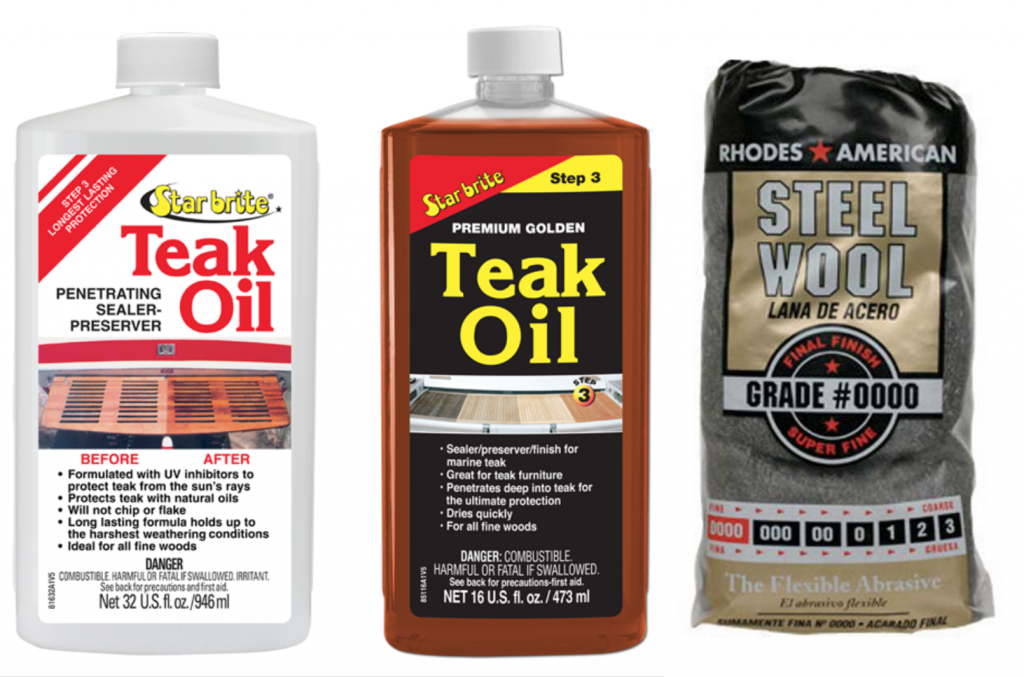
This is the brand of oil I use. It doesn’t have any varnish in it, which makes it especially easy to use. It also doesn’t have much of a solvent odor though if you’re sensitive to such things you might want to use it outdoors or with a respirator.
Get some rubber gloves, too. I use disposable ones and put two on my dominant hand.
The lack of added varnish means the finish is less protective. This is not an issue with chairs, which are mostly what I do; for a tabletop, especially a dining table, you might want to use something like Watco Danish Oil which does contain varnish. The application process for that is a little different.
Ace Hardware stores in the US carry Star-Brite oil and you can get #0000 steel wool in any hardware or paint store. I do not recommend anything coarser than #0000 as you might end up leaving marks in the wood.
I use the teak oil in the white bottle. I think the only difference is that the stuff in the black label has some color added to it, which so far I’ve never needed for anything.
Another tip: do NOT remove the paper seal on top of the bottle under the cap! Just poke a small hole in it, like toothpick-sized. Once you get going on a project, the outside of the bottle can get very slippery and I can pretty much guarantee that you’ll lose your grip on it or just knock it over accidentally at some point. A small hole will prevent a gusher of a spill.
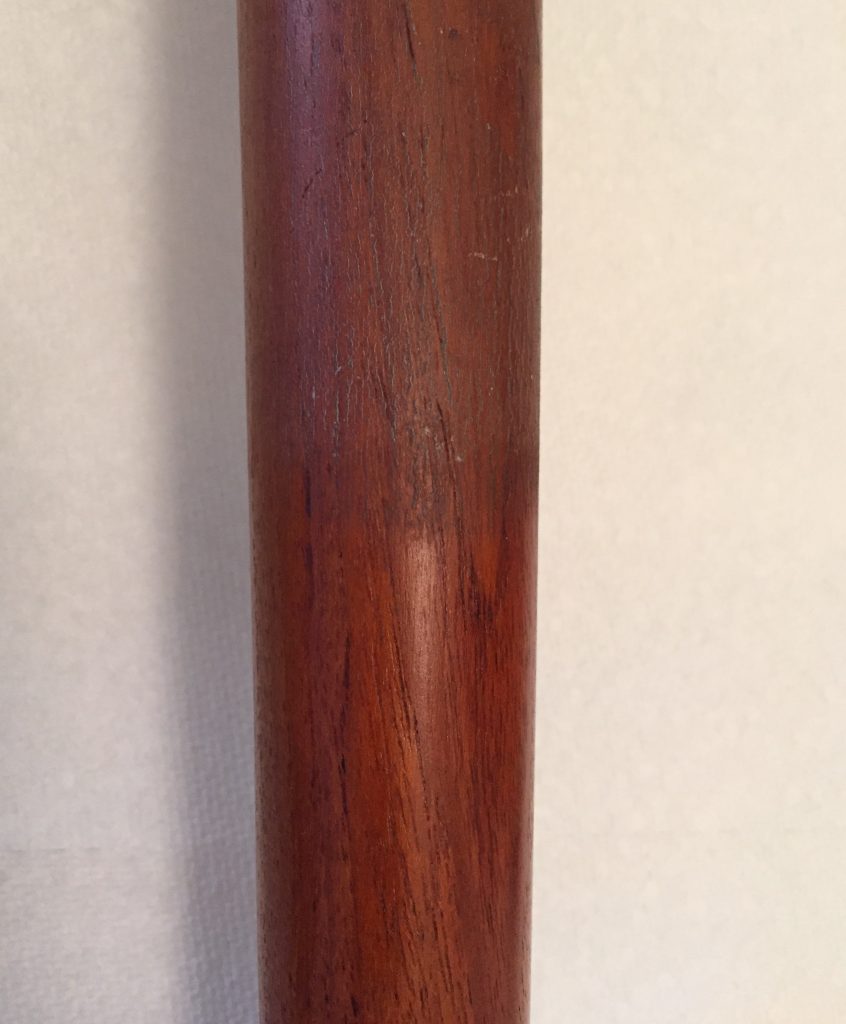
Even for wood that looks ok, oiling can make a noticeable difference. This chair leg wasn’t particularly dirty, just a bit dull. Oiling brightened it and gave it a lovely soft sheen.
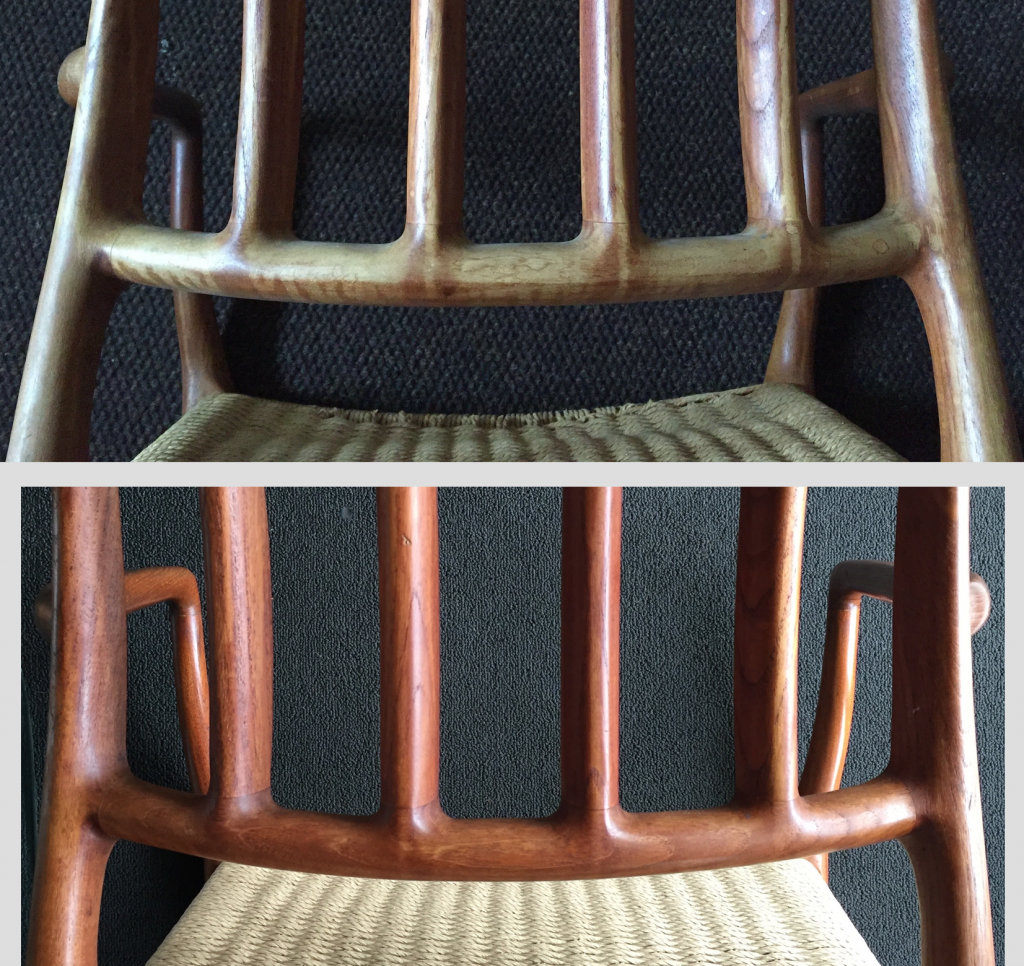
I don’t know what happened to this chair above–looked like something had poured over the back and leeched out the color and oil! I’d never seen fading like that and I kind of assumed it would need sanding or added color somehow, or at the very least multiple coats of oil.
Turns out all it needed was the usual one coat of oil, applied with maybe slightly more vigorous steel wooling. I was amazed.
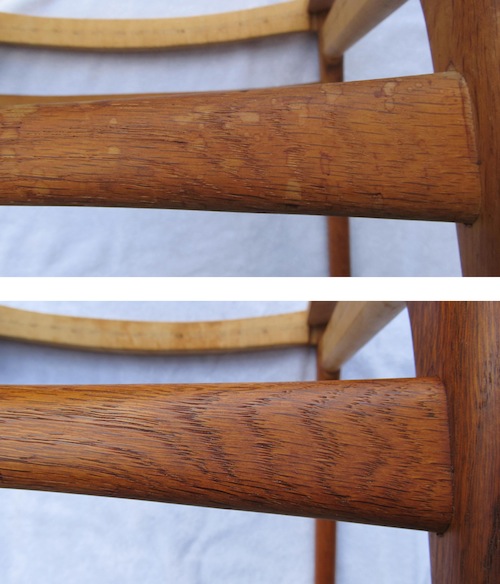
Water spots like in the top half of the photo above are very common and usually disappear with oiling, or at least can be made nearly unnoticeable. You may have to take more time with the steel wool but it’s still preferable to sanding. Sanding removes top cells of the wood and that’s where all the deeper color of age is.
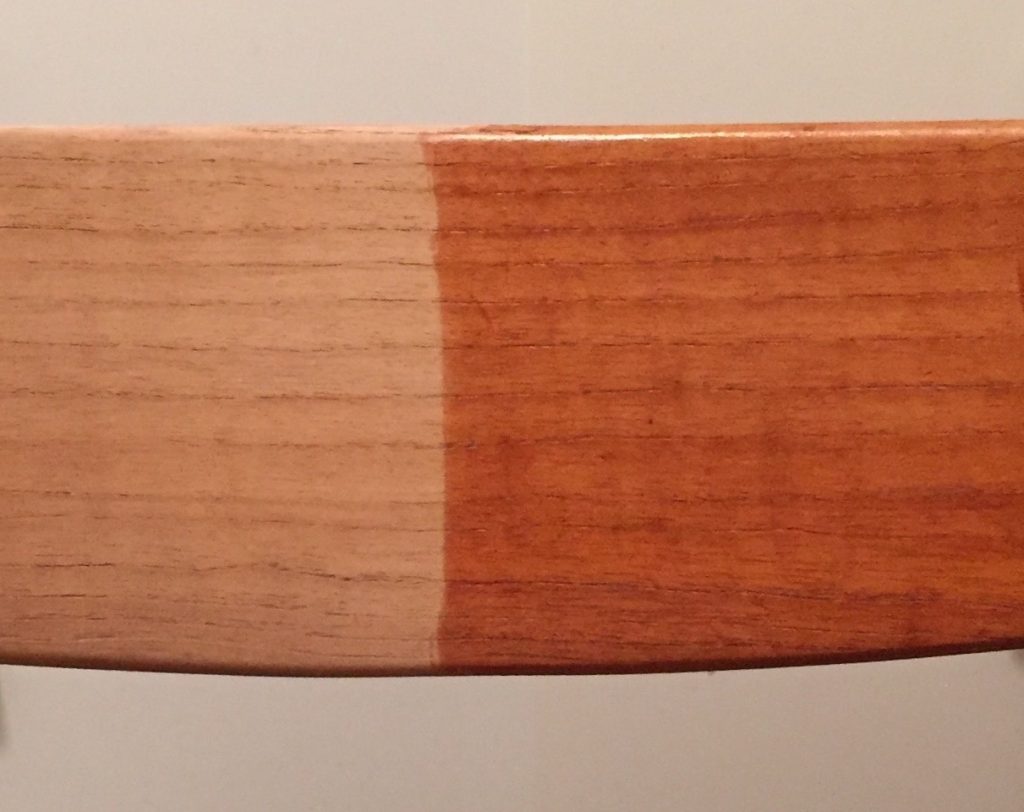
Once in awhile you’ll come across some teak that was lacquered, varnished or even shellacked at some point in its life. Some teak was lacquered by the manufacturer; I guess to give it a higher sheen…? The problem with lacquer is that it chips off rather than wearing down evenly as varnish does. If you oil something that has chipped lacquer, you’ll notice that it gets darker where the lacquer had chipped off but there’s no color deepening on the rest of it. I just strip the lacquer off if this is the case. I’ve also come across a few chairs that had been varnished by a homeowner years ago; same with some shellacked ones.
Refinishing is a whole other post. I just want to say here that for teak that is seriously dry, like in the photo above (after chemical stripping, which is very drying) you might think there’s no hope. I mean, we’re talking Sahara Desert dry. But you can see the amazing transformation with oil. You will probably need 2 coats and maybe even 3 over the space of a week, but it’s still a very doable fix.
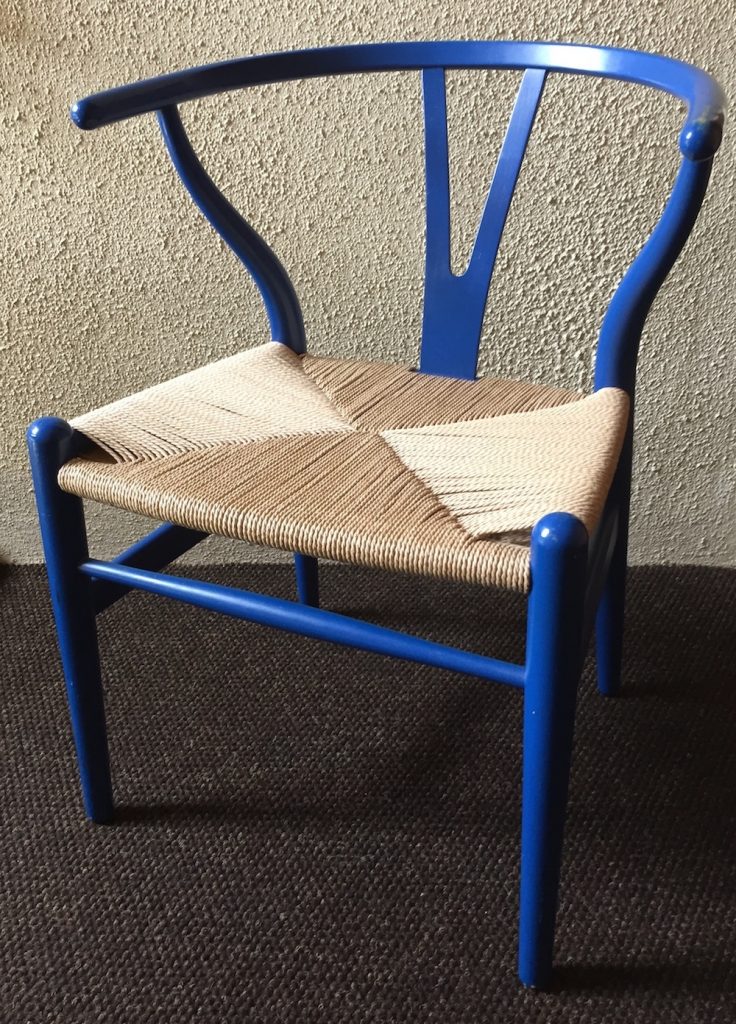 This is one of a group of eight or ten older Hans Wegner wishbones that I did over several years for one family. I love this blue! It’s so Danish.
This is one of a group of eight or ten older Hans Wegner wishbones that I did over several years for one family. I love this blue! It’s so Danish.
 The new cord looks especially crisp with the blue.
The new cord looks especially crisp with the blue.
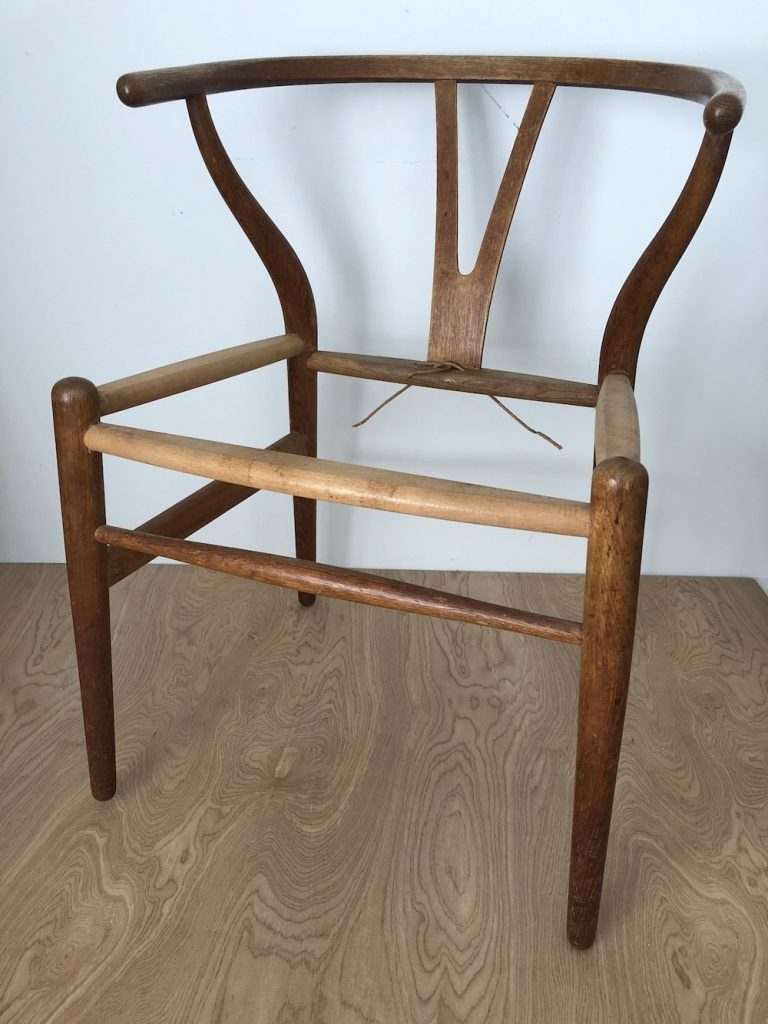
Most of the chairs were oak with an oil finish that had the usual issues that come with use and age: water spots, a few food stains here and there—nothing serious, just stuff that needed to be cleaned up.
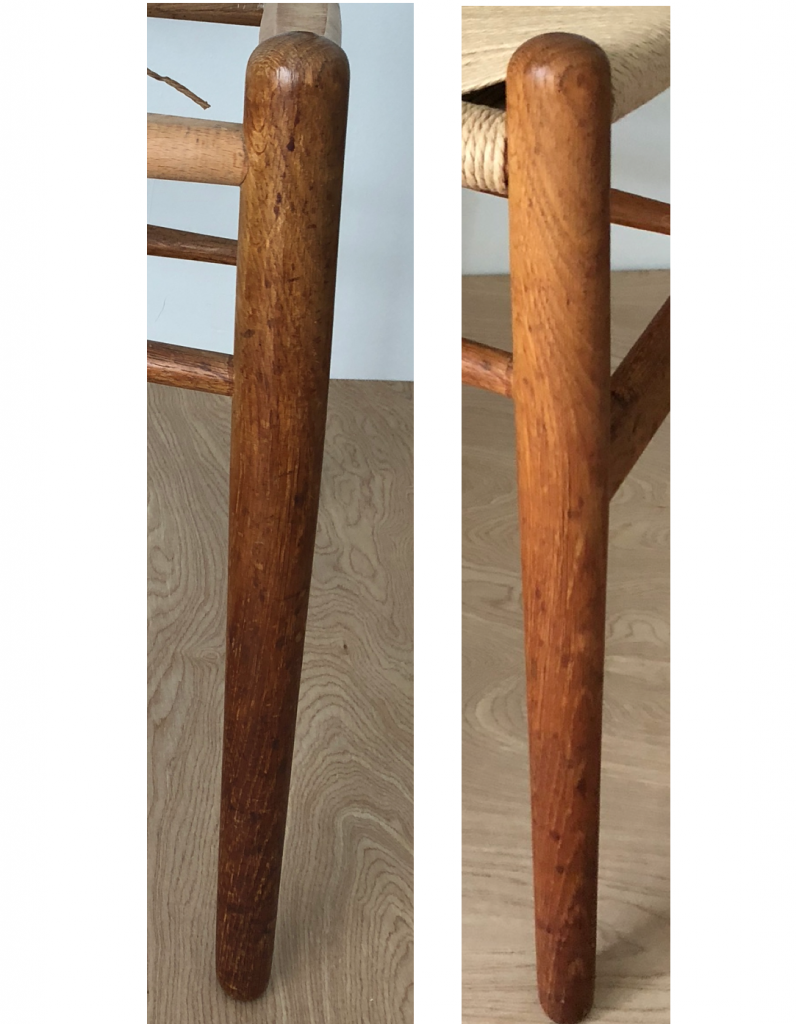
A once-over with #0000 steel wool and teak oil not only removes most minor stains but also brightens the wood a bit and shows off the grain better.
You can also remove most paint scuffs that happen when the chair is scraped against a wall or doorway–no need to resort to harsh Goof-Off and similar products.
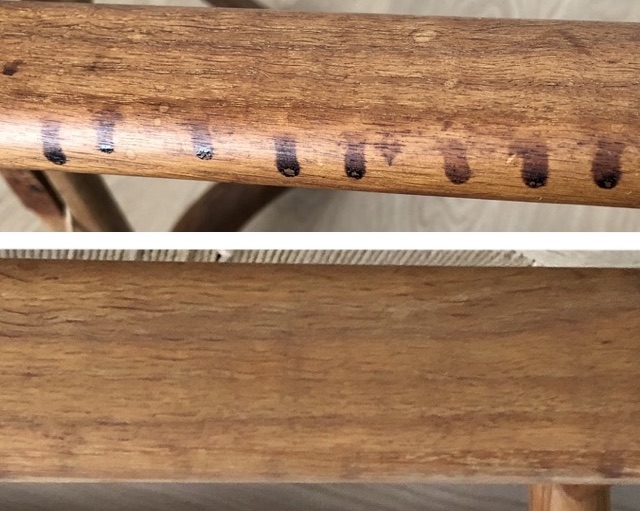
There’s a certain kind of stain that I see a lot, shown in the top half of this photo. I suspect it’s from a drink that has sugar, probably nothing more than juice, wine or soda. I imagine it’s easy to miss when it happens but eventually it turns dark like this.
The weird thing is that it doesn’t come off easily with the steel wool and oil—BUT if you just give it a few swipes with a damp rag it will dissolve immediately. You will find it on the underside of chair rails like here. (That’s the same rail before and after treating with a damp rag, then steel wool/oil to remove residual marks. You can still see the drips faintly but they’re on the underside of the rail so a few shadows aren’t a big deal.)
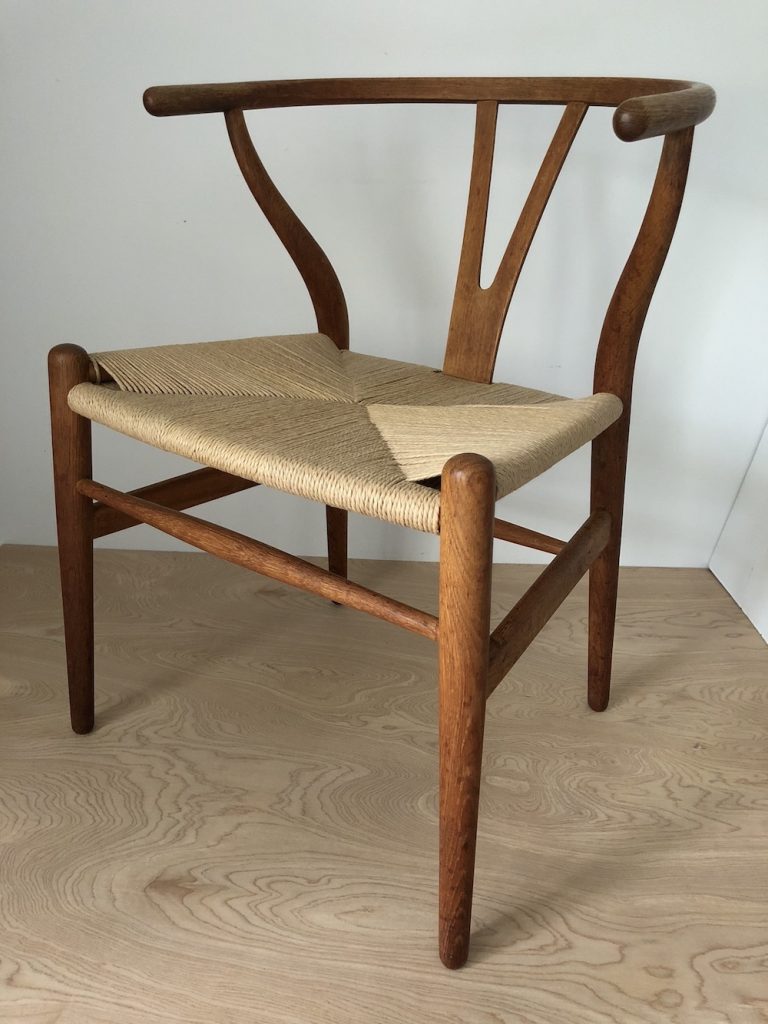
Ready to go!
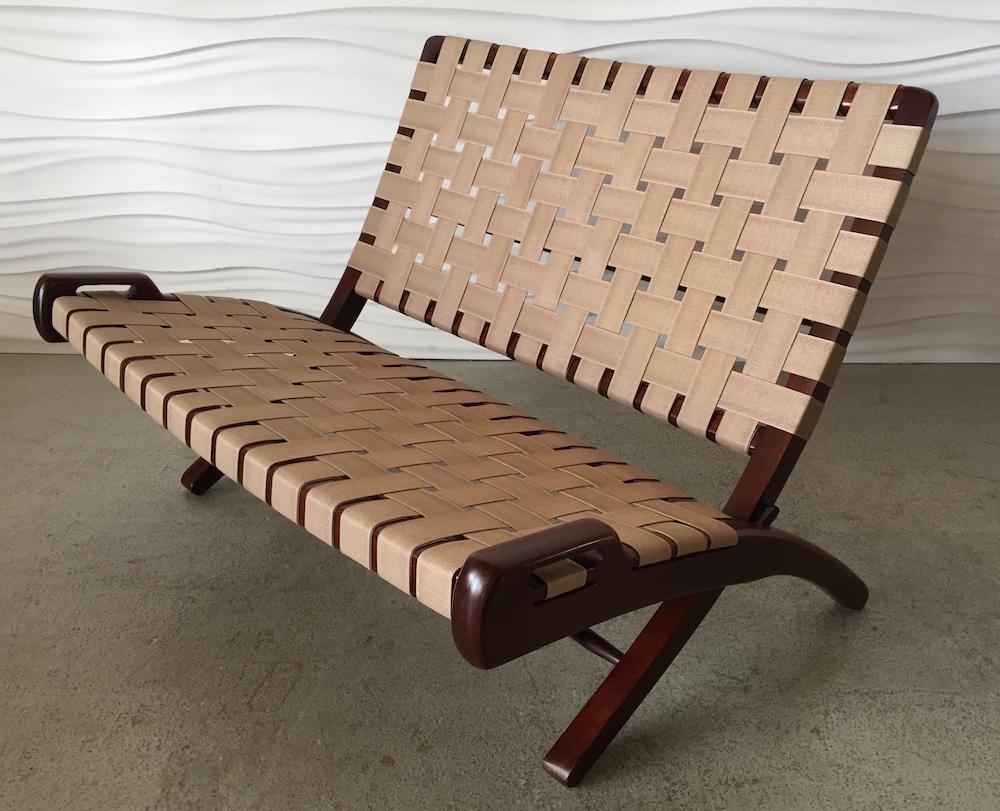 Awhile back I wove this new seat and back for this rare folding settee in the Hans Wegner style that is so popular. I’d never seen a settee version before, only the chair in a few variations. This was made in Yugoslavia.
Awhile back I wove this new seat and back for this rare folding settee in the Hans Wegner style that is so popular. I’d never seen a settee version before, only the chair in a few variations. This was made in Yugoslavia.
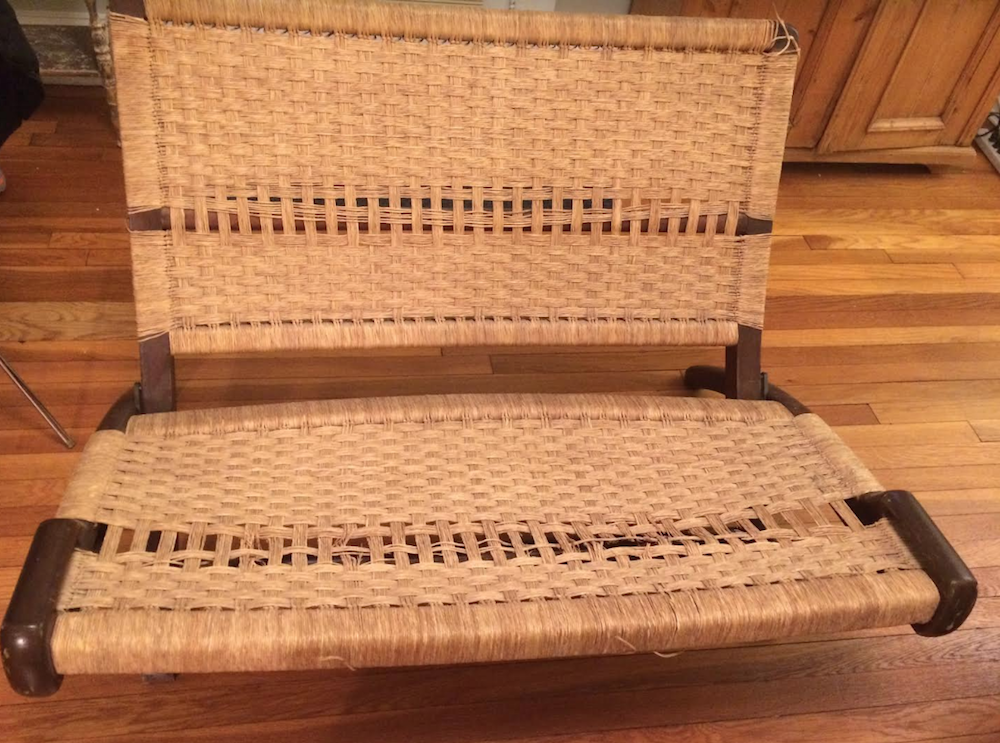
Originally it had the usual woven cord seat but this one was the material that is similar to seagrass but not quite seagrass. It also had a finer texture than the more commonly used cords and was frayed and broken in many places though it doesn’t look so bad in this photo.
You also can’t really tell from this photo how much heavier the settee frame is than the chair frames. It’s much beefier and the fine weave didn’t really suit it.
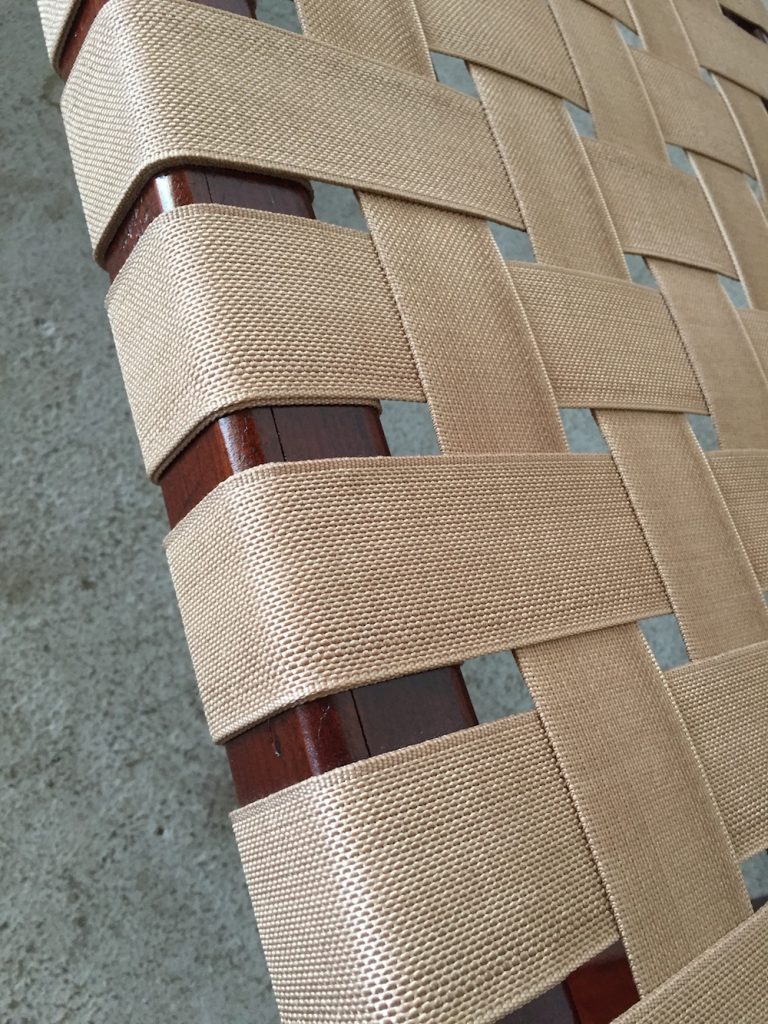 The owner decided on this 2″ wide webbing. It looks like linen but it’s actually polypropylene. She also had the frame refinished.
The owner decided on this 2″ wide webbing. It looks like linen but it’s actually polypropylene. She also had the frame refinished.
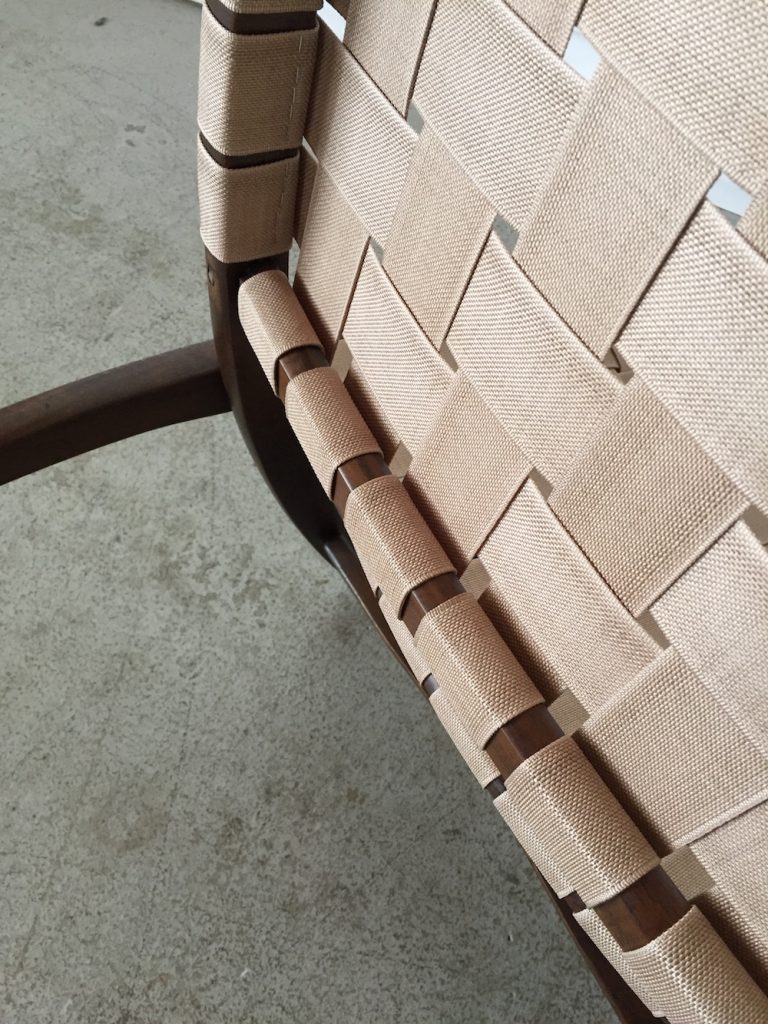
There’s no way to keep the staples from showing on one end of each strap on the back. I like the bottom rail to look good because that’s where your gaze is most likely to fall, so I stapled the strap then wrapped it around once so that the stapled end was covered.
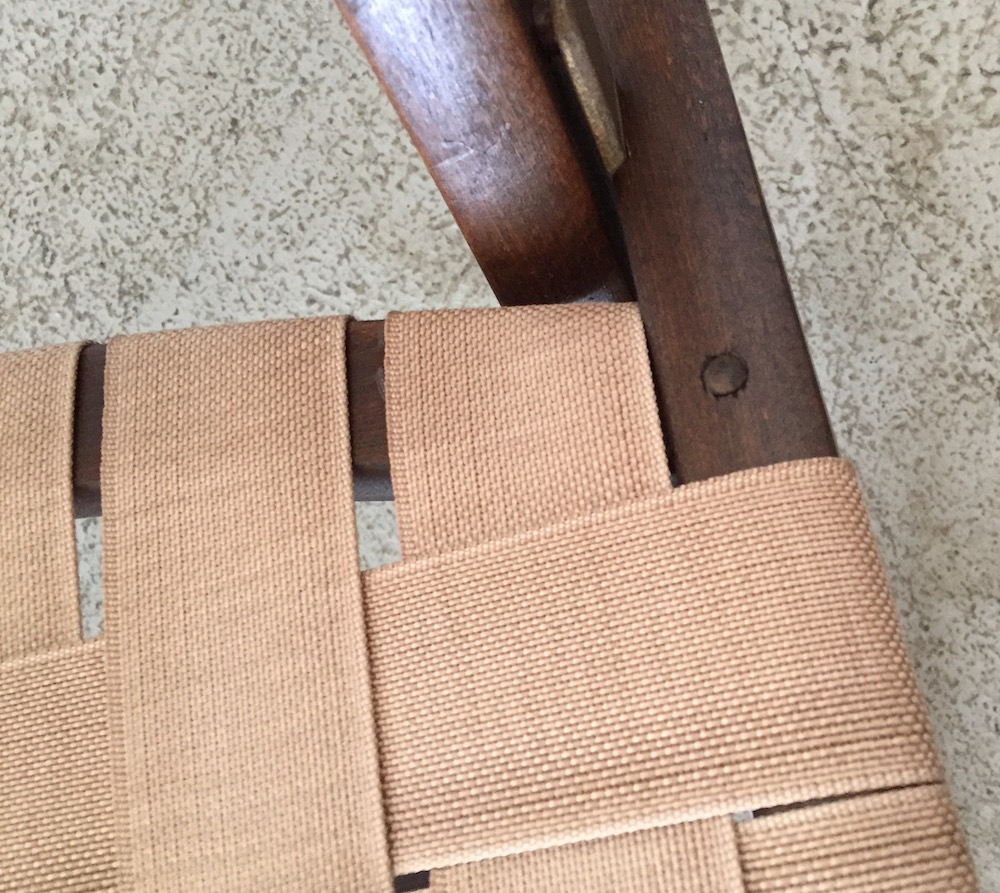 The joinery on these Yugoslavian folding chairs and other things is not the best workmanship and I was worried about the seat joints working loose over time as is usually what happens. I put a peg through the tenons to secure the joints. It had to go through the top on the back corners because there no access from any other direction.
The joinery on these Yugoslavian folding chairs and other things is not the best workmanship and I was worried about the seat joints working loose over time as is usually what happens. I put a peg through the tenons to secure the joints. It had to go through the top on the back corners because there no access from any other direction.
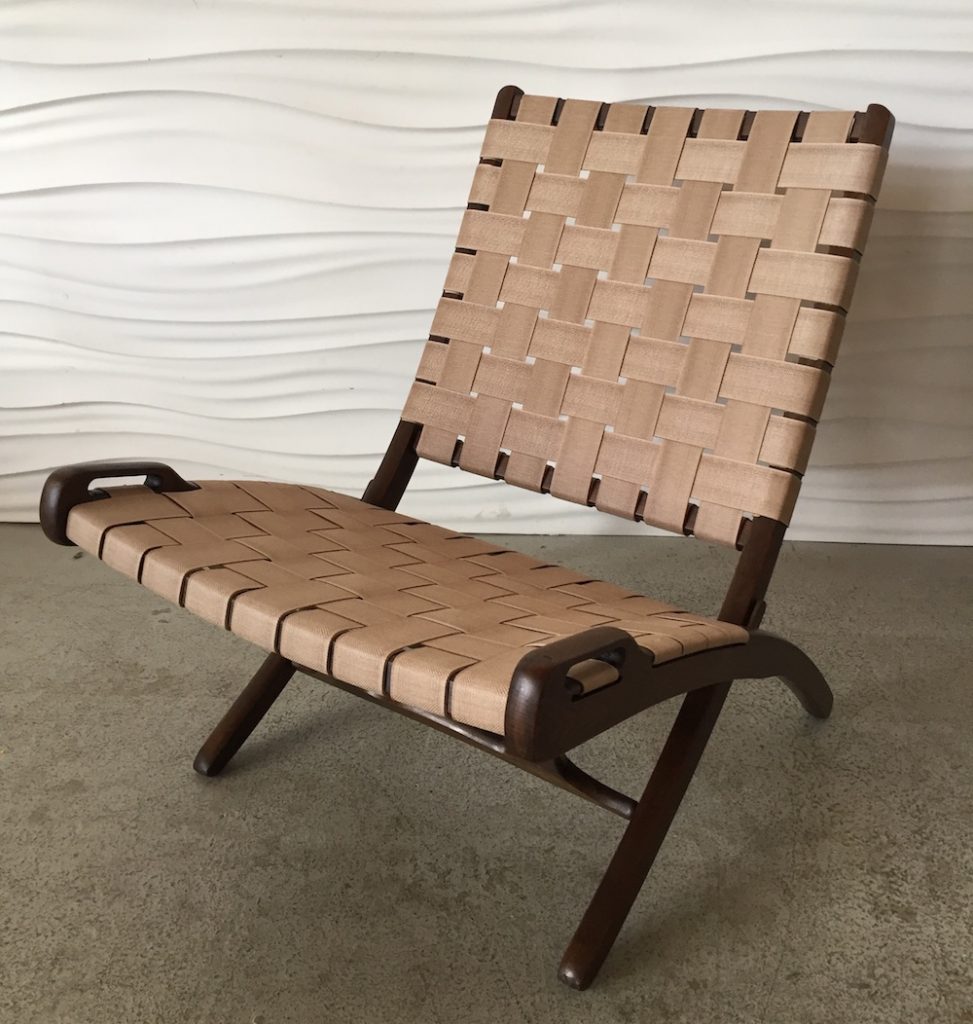
She also had this Yugoslavian folding chair done at the same time. They make a nice set!
Special thanks to Home Anthology for letting me snap photos in their shop.
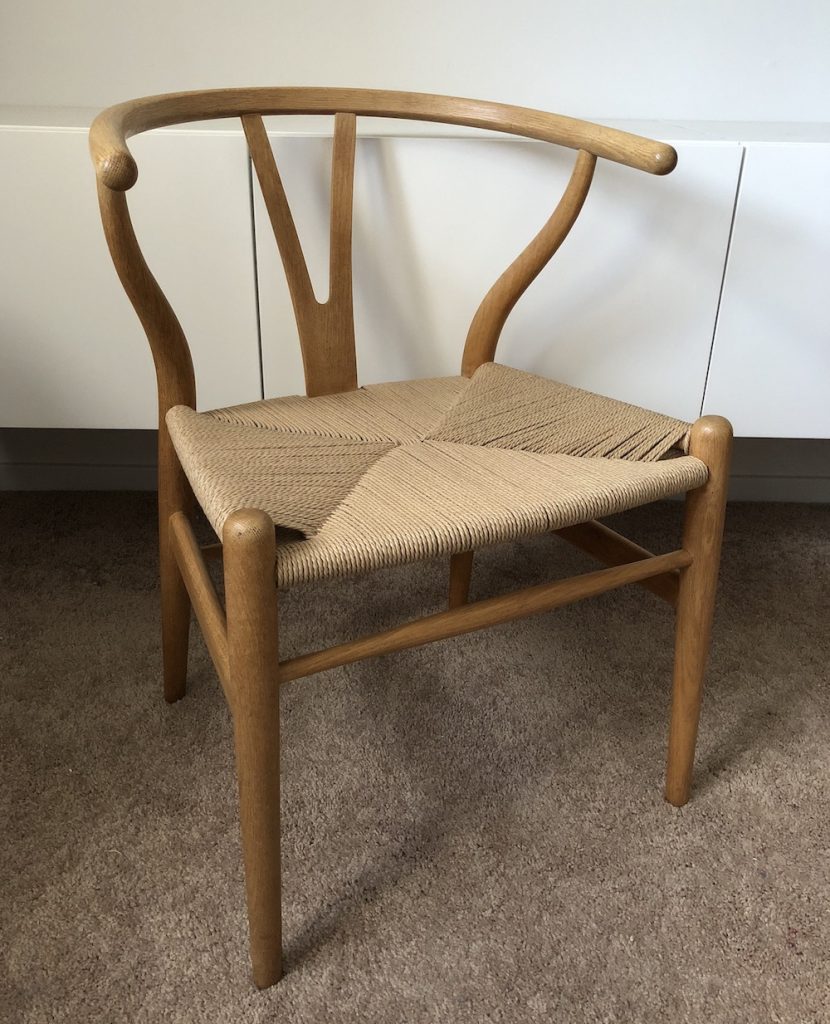 Recently I restored a set of eight of these beautiful oak wishbone chairs. I thought the owner said they had a wax finish but I was happy to discover that it was just soap. The frames looked pretty good but did need cleaning up a bit. All I needed to do was gently scrub them with plain water to rinse off the old soap, let them dry thoroughly, then soap them up again!
Recently I restored a set of eight of these beautiful oak wishbone chairs. I thought the owner said they had a wax finish but I was happy to discover that it was just soap. The frames looked pretty good but did need cleaning up a bit. All I needed to do was gently scrub them with plain water to rinse off the old soap, let them dry thoroughly, then soap them up again!

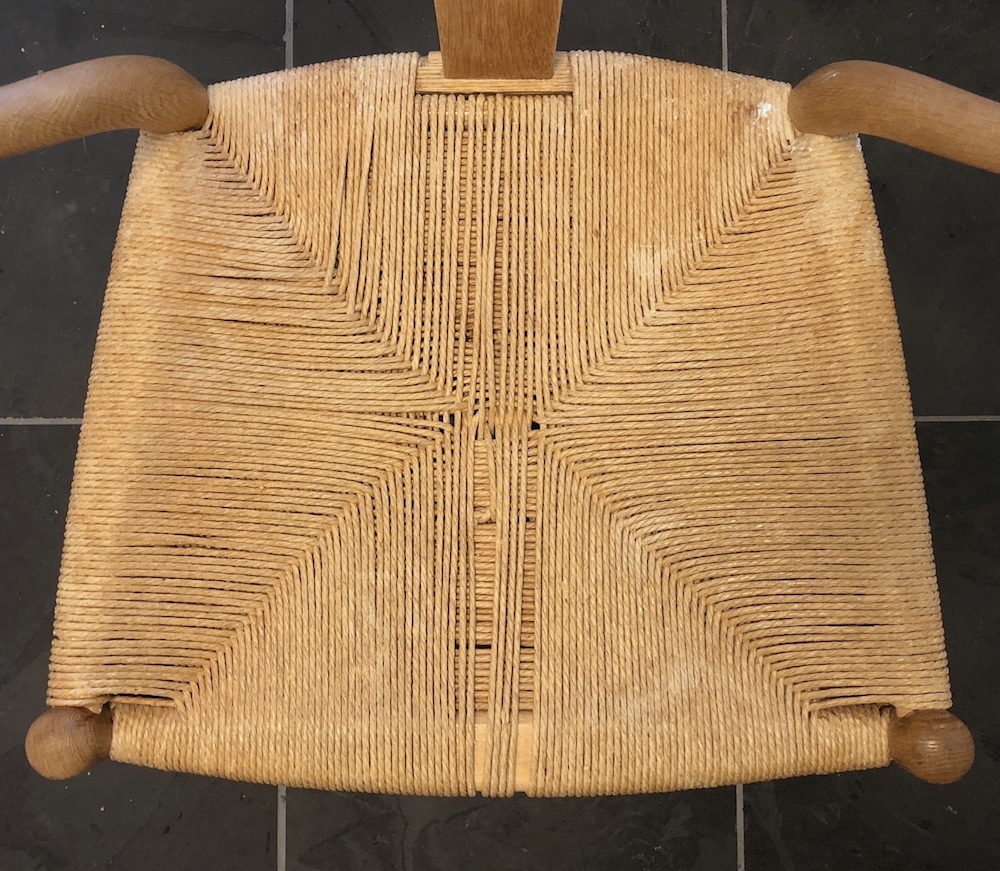 This was one of the better seats. Most of them had some broken strands and this same spreading in the center. There’s no way to fix that short of reweaving.
This was one of the better seats. Most of them had some broken strands and this same spreading in the center. There’s no way to fix that short of reweaving.

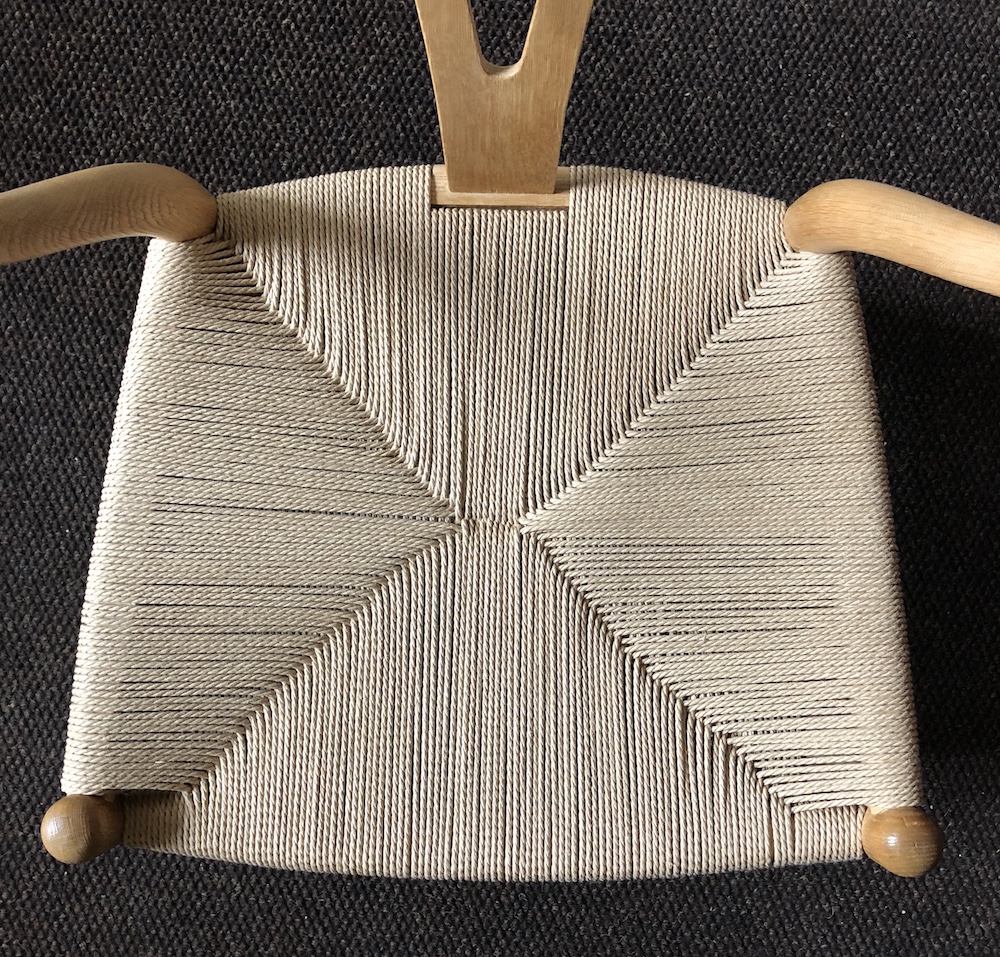 The new seats should last a few decades.
The new seats should last a few decades.

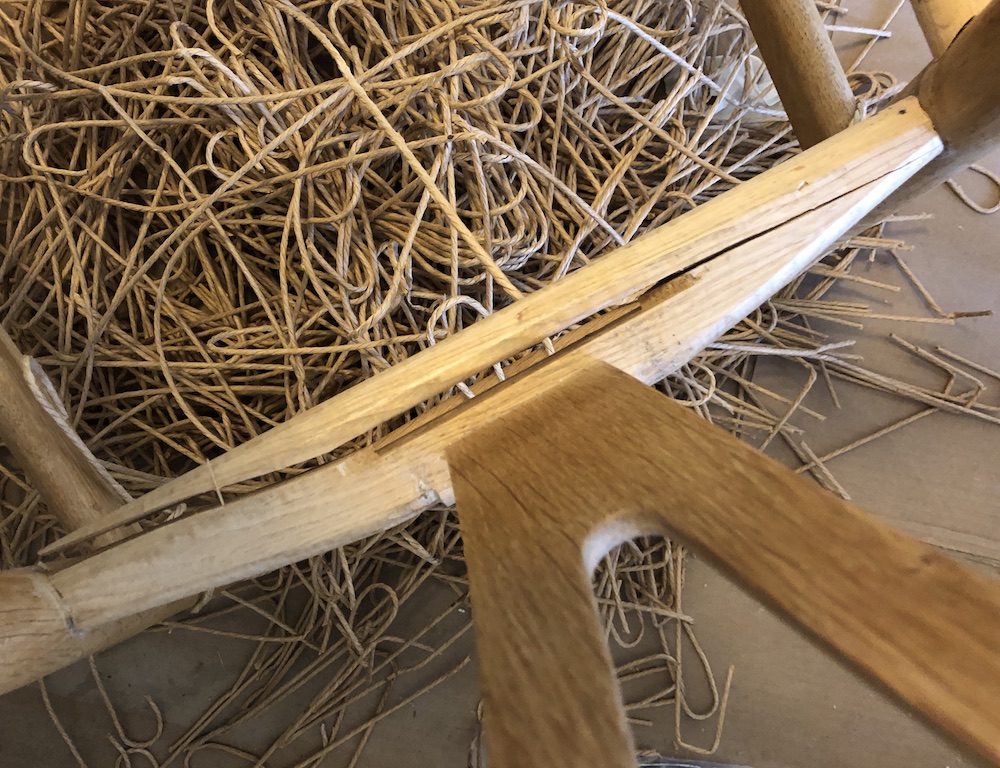 I got a little surprise on the last chair after stripping off the old cord. The oak rail at the back of the seat had split cleanly along the grain. Luckily neither tenon was involved.
I got a little surprise on the last chair after stripping off the old cord. The oak rail at the back of the seat had split cleanly along the grain. Luckily neither tenon was involved.

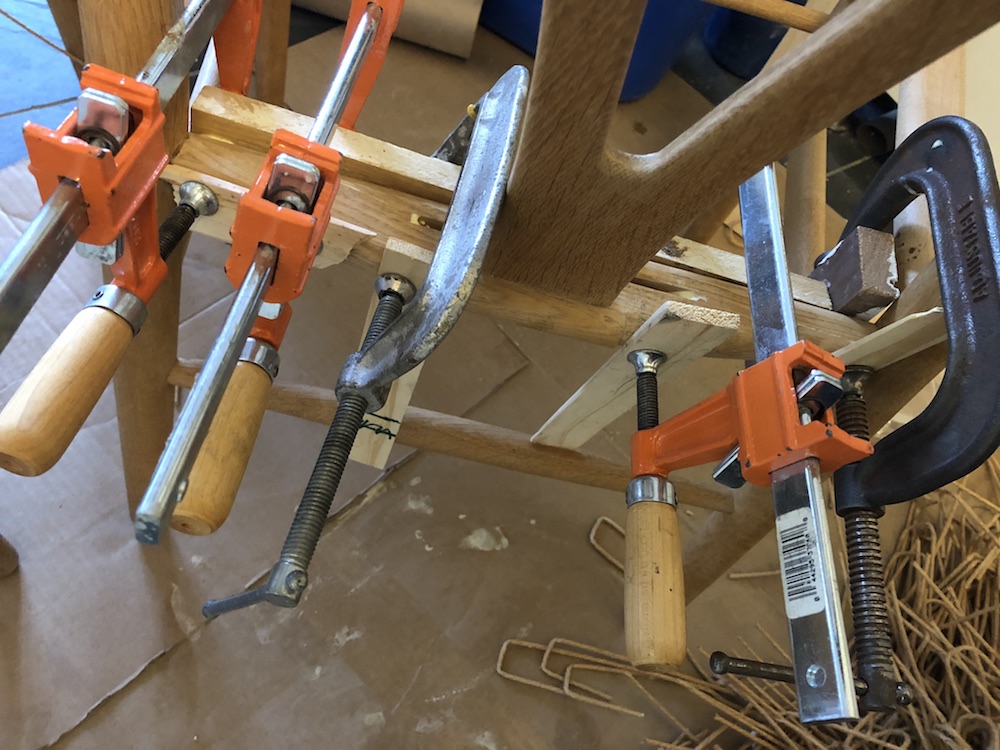 A little yellow wood glue and a few clamps did the trick. (Special thanks to my friends at Design Addict for their repair advice.) The rail is as good as new now.
A little yellow wood glue and a few clamps did the trick. (Special thanks to my friends at Design Addict for their repair advice.) The rail is as good as new now.
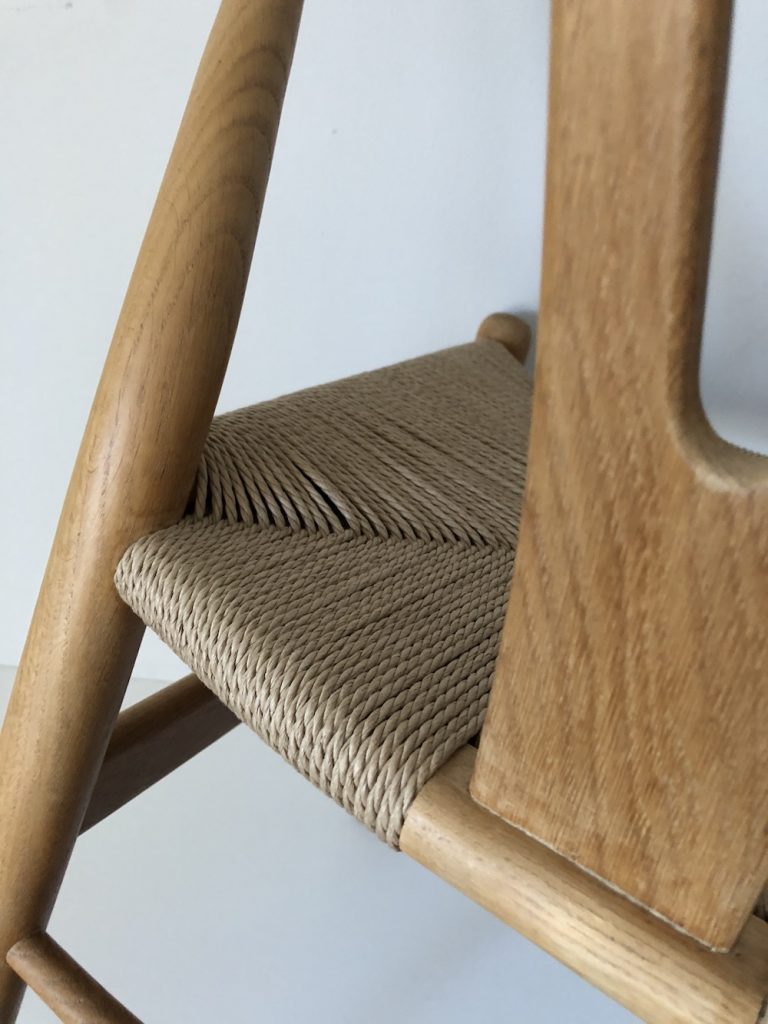 Soaping is just a matter of grating Ivory soap and mixing it with hot water to a fluffy consistency. Apply it to the wood and wipe off the excess, leaving a thin film that will dry. Then just buff. It’s appropriate for any light-colored wood and gives it a soft sheen and a very silky feel.
Soaping is just a matter of grating Ivory soap and mixing it with hot water to a fluffy consistency. Apply it to the wood and wipe off the excess, leaving a thin film that will dry. Then just buff. It’s appropriate for any light-colored wood and gives it a soft sheen and a very silky feel.
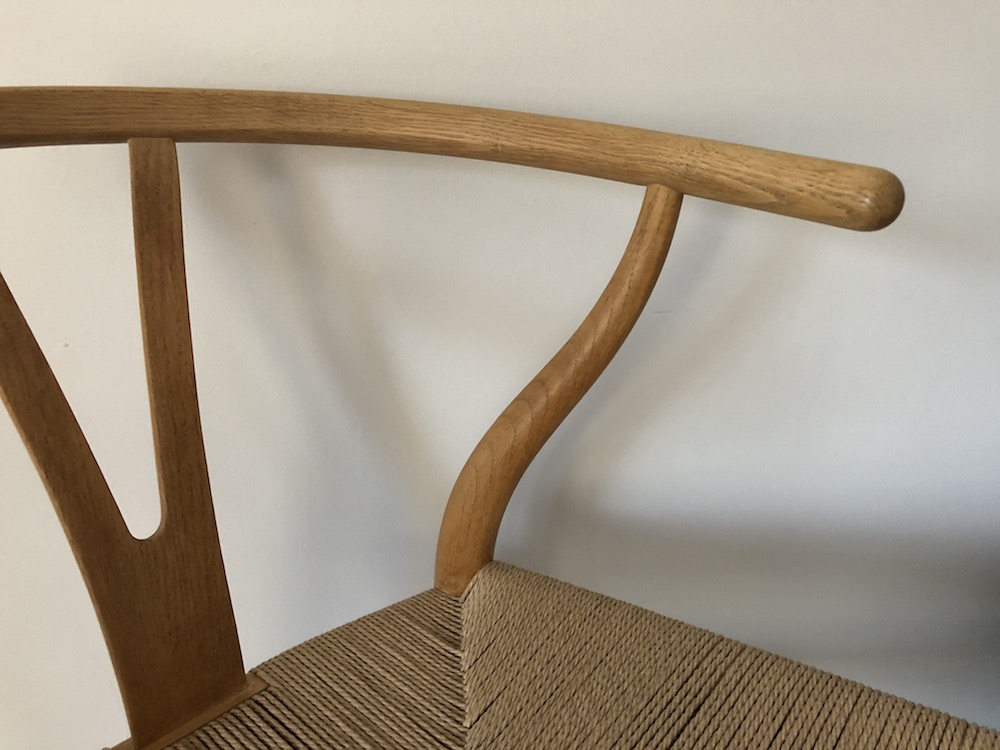 A soap finish also keeps future grime from working its way into the pores of the wood. When the wood starts to look a bit grimy, all you need do is give it a light scrub with water, let dry, then soap up again. I use white 3M Scotch-Brite pads from Ace Hardware (the green ones are easier to find but sometimes leave green color behind).
A soap finish also keeps future grime from working its way into the pores of the wood. When the wood starts to look a bit grimy, all you need do is give it a light scrub with water, let dry, then soap up again. I use white 3M Scotch-Brite pads from Ace Hardware (the green ones are easier to find but sometimes leave green color behind).
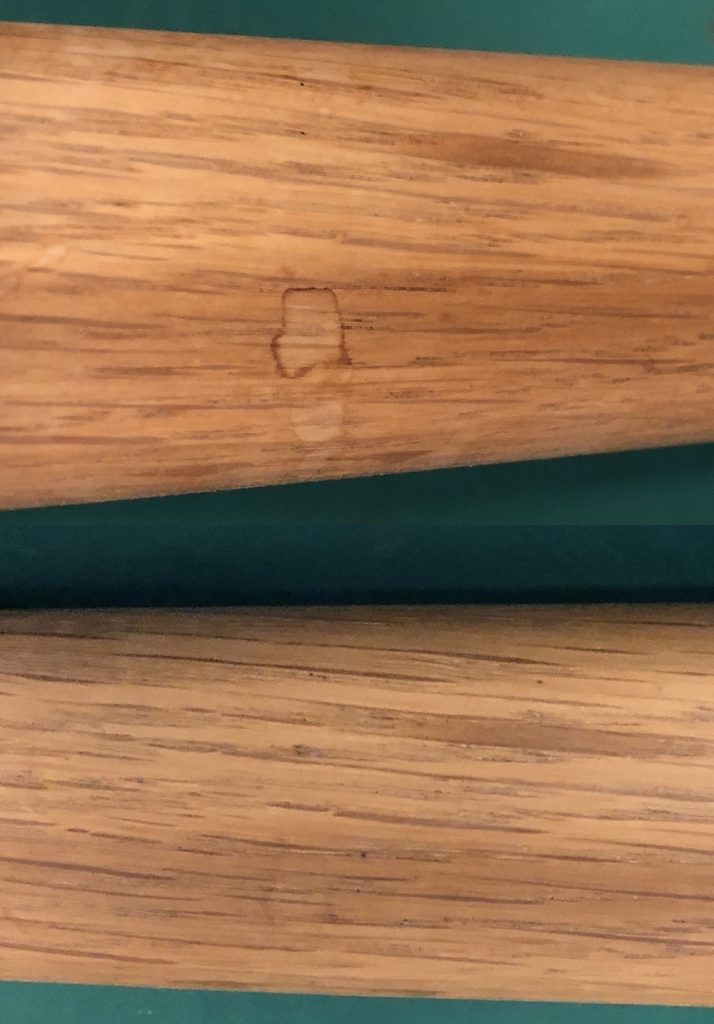 Light stains like the one above easily cleaned off with soap. You can still see a faint outline of the spot at close range but it’s pretty light!
Light stains like the one above easily cleaned off with soap. You can still see a faint outline of the spot at close range but it’s pretty light!
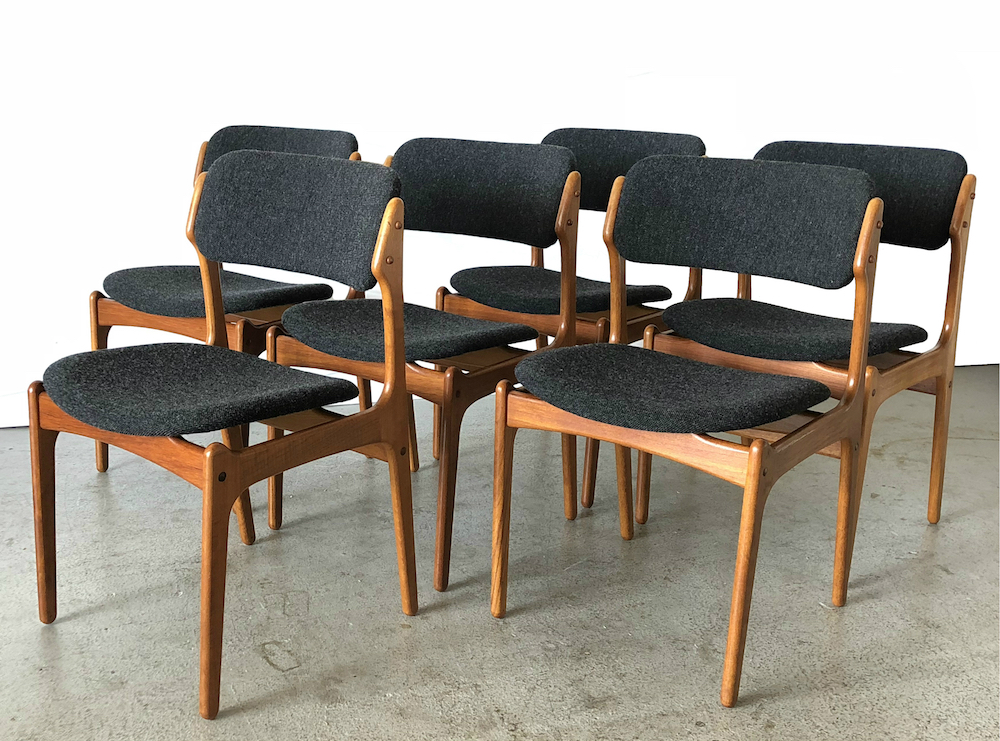
I just finished this set of six Erik Buch dining chairs in one of my favorite fabrics, Maharam/Kvadrat’s Hallingdal in the 180 colorway, a very dark charcoal gray. All the photos here are deliberately overexposed a bit so that the details are visible. The actual fabric color is darker (swatch below).
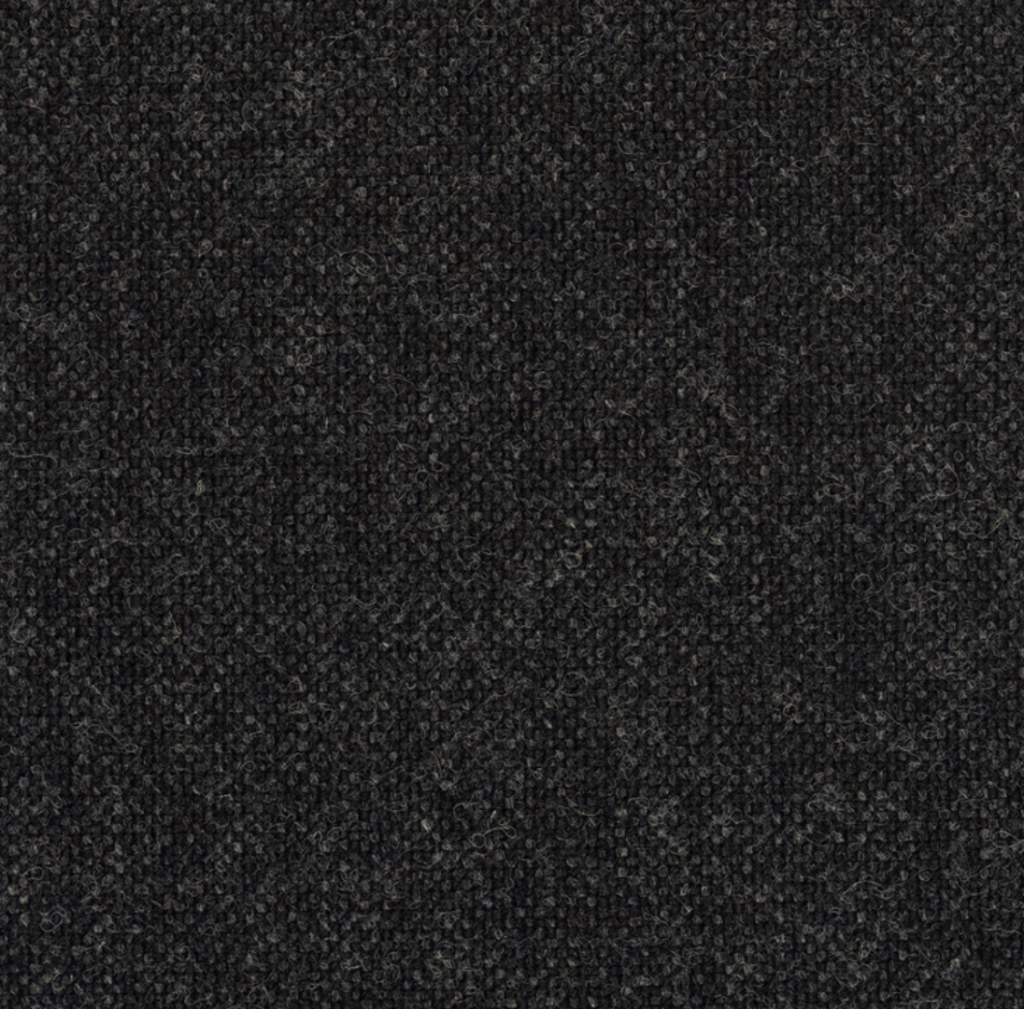
Hallingdal was designed by Nanna Ditzel of Denmark in 1965 and has been in production ever since. It’s 70% wool, 30% nylon for durability, and comes in 57 other gorgeous colors besides this charcoal gray.
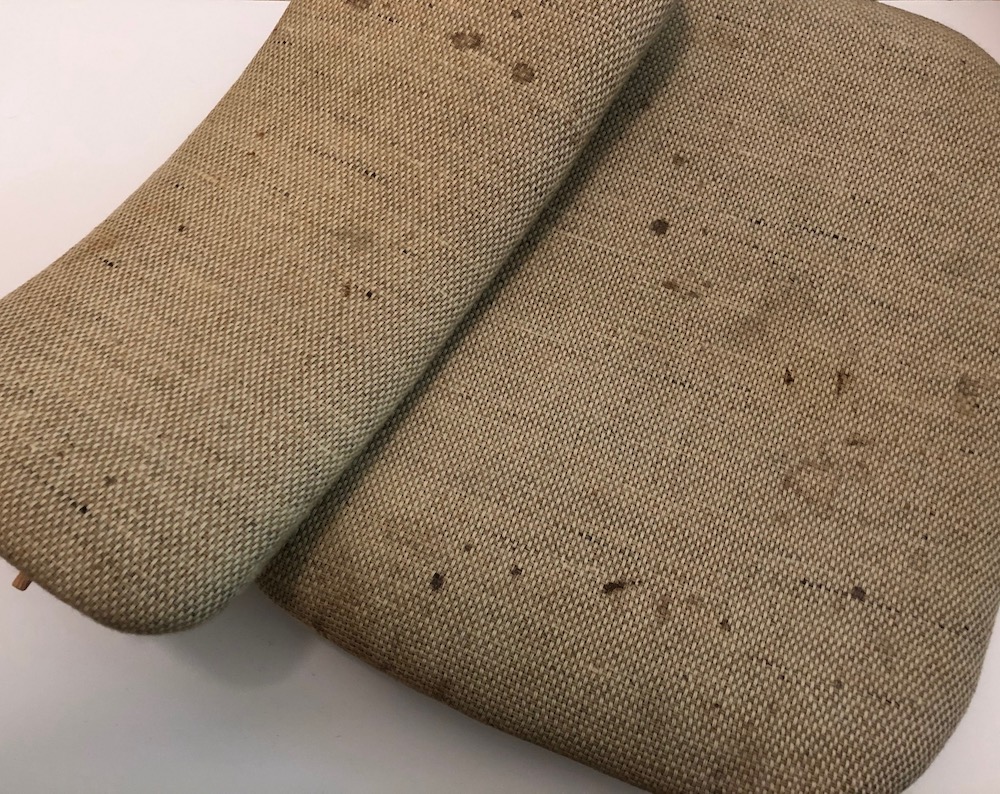
The original seats had the usual beige wool that was used many Buch chairs. It was very, very dirty. When the fabric is this bad, you can pretty much count on the foam being dirty, too.
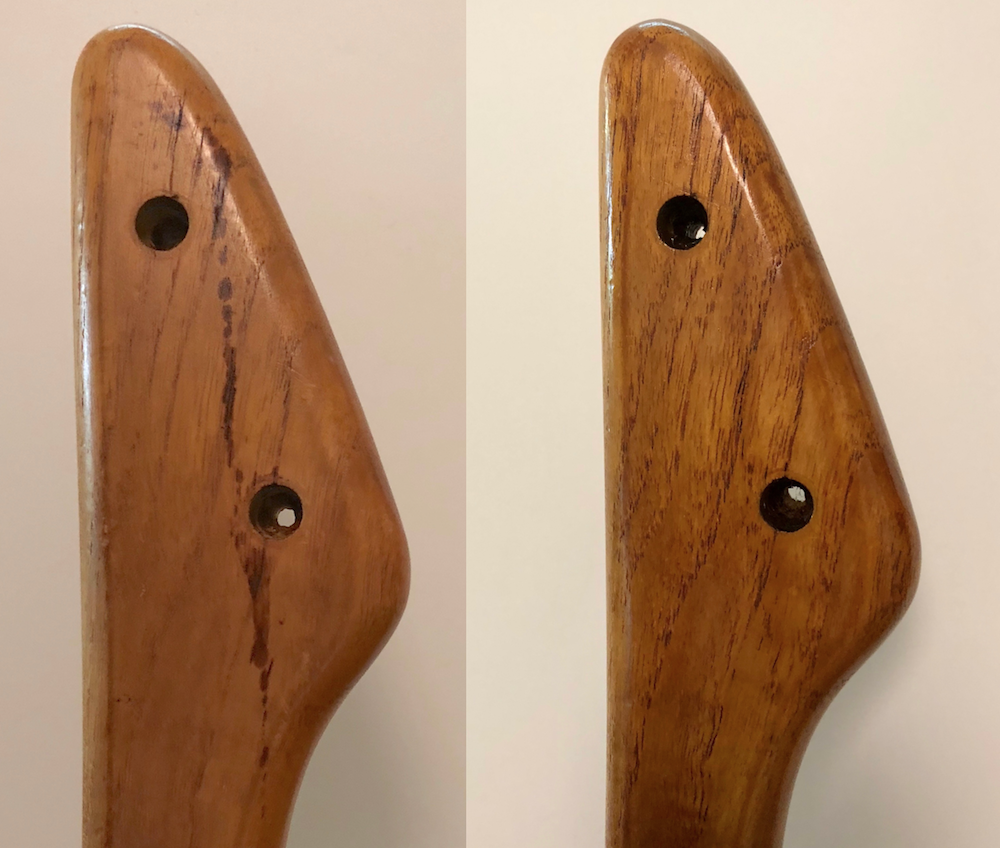
The frames were in pretty good shape except for a few large, dark mystery stains. This one was on the outside surface of the top of one of the leg posts. Fortunately I was able to get it out!
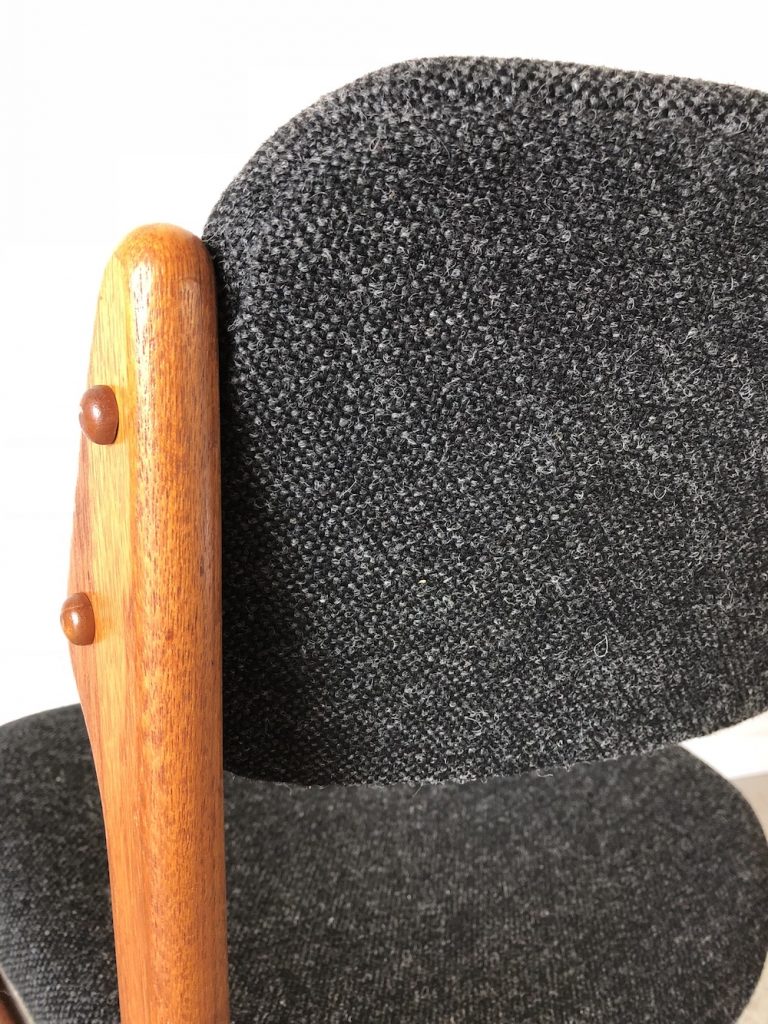
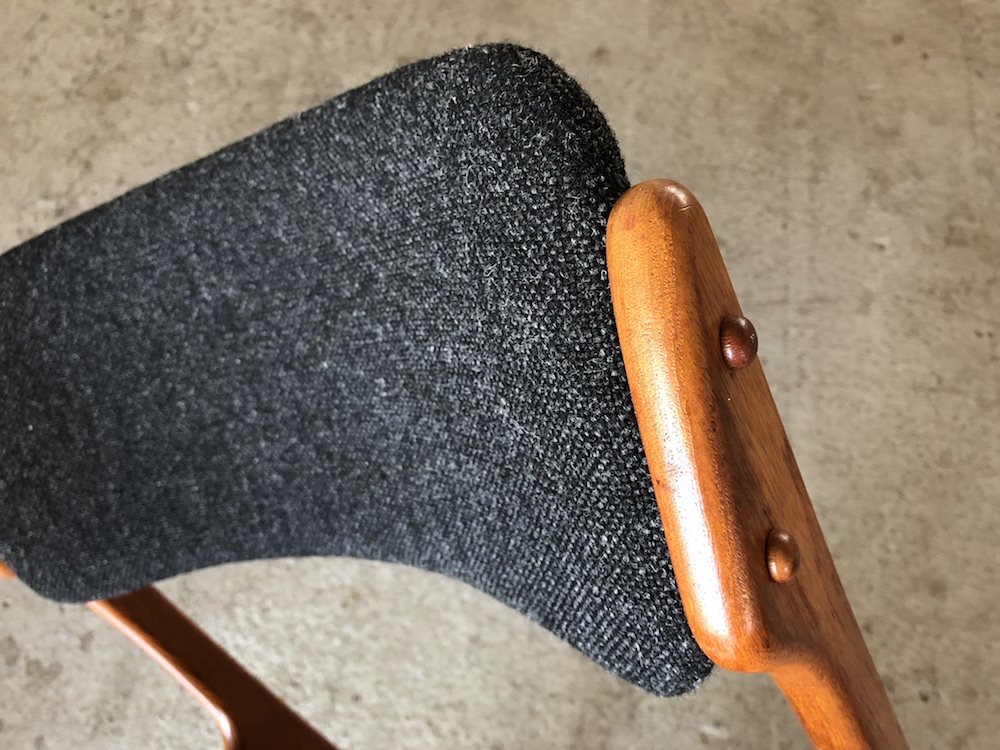
These chairs have always been my favorites for comfort. The secret seems to be in the shape and angle of the backrest.
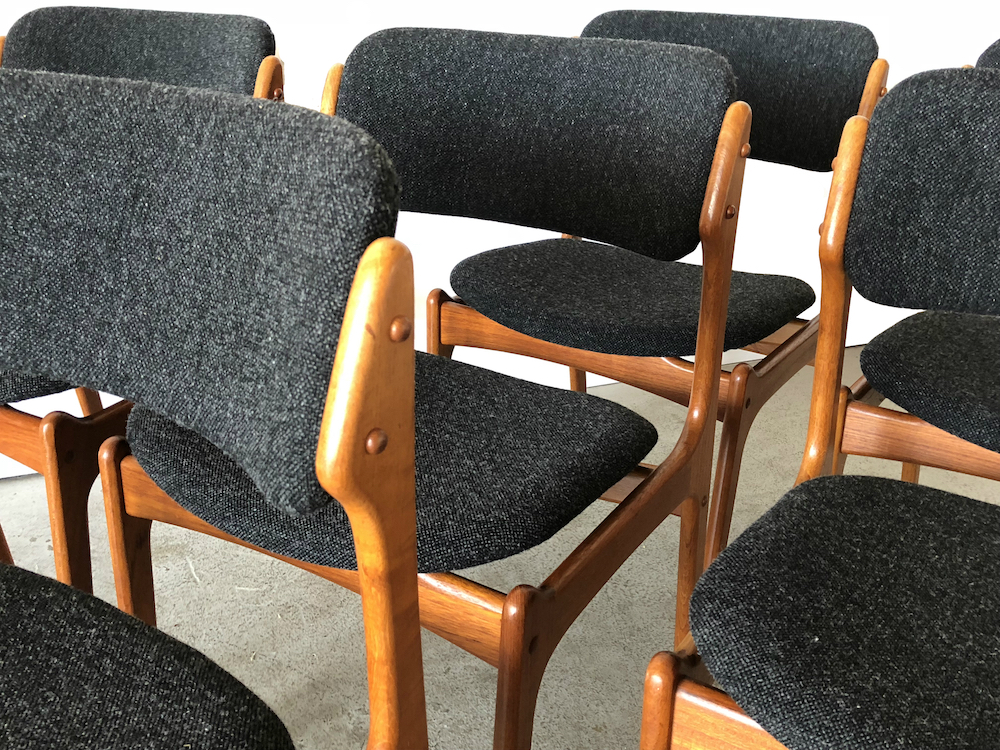
Hallingdal is a very sturdy fabric that will last for decades with reasonable use. It also goes around curves beautifully and is easy to work with.
✢ ✢ ✢
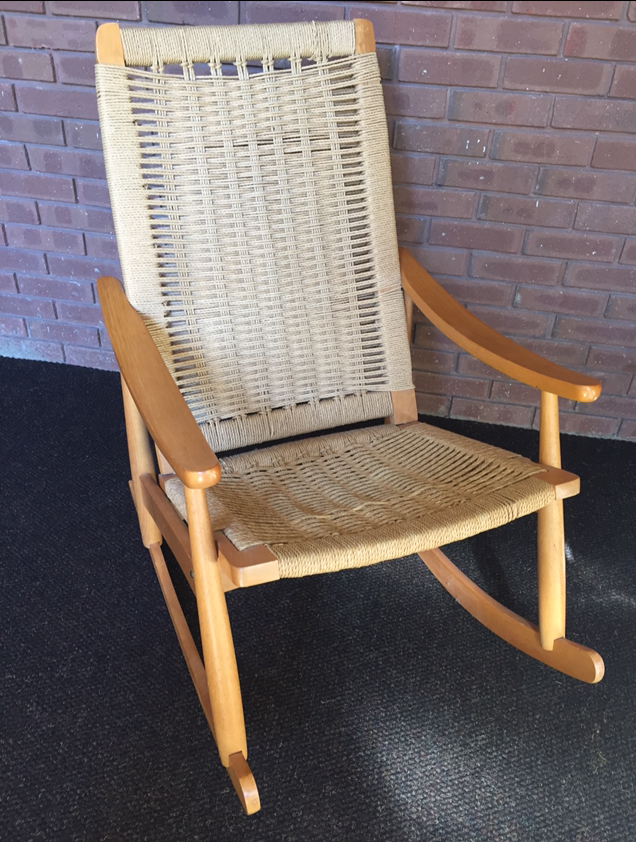
I don’t usually get so many Yugoslavian chairs at once to reweave and this second rocker so soon after the last one kind of got me thinking about other approaches. I know that these are often compared to Hans Wegner’s rocking chairs but they’re really not very similar. I guess it’s just all the paper cord weaving on them that people focus on.
The weaving on this one wasn’t in as poor condition as many, but like most, it was loose and sagging. They were done this way originally, I think.
I had an idea for something completely different.

This is 2″ wide polypropylene webbing, very similar to the nylon webbing of Jens Risom chairs. I really like it with the beech frame!
And, it’s just stapled on and is completely reversible. No alterations were made to the frame, other than sanding and finishing the parts that were covered with cord (originally unfinished and rough cut, since they didn’t show at all). If someone, someday, wants to redo it in paper cord, it can easily be done.


I thought about using cotton webbing, but cotton is very hard to clean. (It’s fine if you can throw it in a washing machine–but that’s not exactly possible with this application!) There’s also nylon webbing, which has a glossy sheen and would work well. And there’s seat belt webbing, which would work well except that it looks like—well, seat belts.
One of the things that’s nice about this chair is that it has that mid-century modern look but with a greater seat height than many, making it a good choice for people who have a hard time getting out of low chairs. The arms and high back make it perfect for feeding and rocking babies, too!
